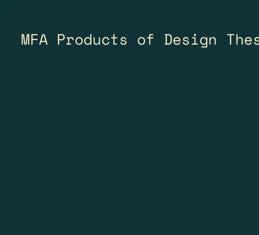




Author Designer
Dedicated to H K Dunston and My Sister, Kranthi Remala, For invoking my interest in chaning the world and showing me how to care the right way!
preface






Author Designer
Dedicated to H K Dunston and My Sister, Kranthi Remala, For invoking my interest in chaning the world and showing me how to care the right way!
preface
On February 10th, 2023, for the Climate Futures class in my term at Products of Design, I presented my manifesto along with my peer Heba Jaleel. It wasn’t until that course and that class that I really knew I had an interest in climate action. Since I was young, my dreams and ambitions were very much towards technology, fashion, travel, and history. Climate was something that I thought was not in the books for me.
However, as I delved deeper into the subject of climate change, I encountered the concept of “slow violence” – a term coined by the literary critic Rob Nixon. Slow violence refers to the gradual and often invisible consequences of environmental degradation, such as the long-term effects of climate adversities - whether natural or manmade. Unlike active violence, which is immediate and visible, slow violence unfolds gradually, making it harder to grasp and address.
One of the key reasons why we often fail to account for the human ramifications of slow violence is the disconnect between the timescales of environmental change and human perception. The effects of slow violence can take years, decades, or even generations to address, making it challenging for individuals and communities to recognize and respond to these threats effectively.
Through this introduction, I aim to explore the concept of slow violence and its far-reaching consequences on human lives and communities. By examining the disconnect between environmental change and human perception, we can better understand why these issues are often overlooked or underestimated. Additionally, by drawing inspiration from works like “Soil Not Oil,” we can shed light on the intricate connections between environmental degradation and the erosion of cultural identities, livelihoods, and human dignity.
Ultimately, this book seeks to amplify the voices of those affected by slow violence and to challenge the dominant narratives that prioritize short-term gains over long-term sustainability and human well-being. By fostering a deeper understanding of the human ramifications of slow violence, we can pave the way for more inclusive and holistic approaches to addressing environmental challenges, ensuring that no community is left behind in the pursuit of a more sustainable and equitable future.






















































In the summer of 2023, I went back home to Hyderabad, India. I had this urge to work with an on-ground organization of some kind, directly or indirectly involved in climate change. I ended up working for a nonprofit through a mutual contact, who later became my Subject Matter Expert (SME). In the course of my involvement with the organization, I realized that the people involved with climate change are where we need to bring about change. Since the age of industrialization, we have seen that humans have been trying to come up with ways to remove humans from geo-engineering with the earth, which started as a petition to make earthly extractions more efficient, and now towards making the earth more sustainable or not harming it. The conversations I had and the readings I consumed were like a mirror - they showed me that my movement for seeking opportunity is a compulsion for many. This sparked a sense of responsibility in me to generate opportunities for them. Moreover, my cultural and ancestral background, with my grandparents being farmers or involved in farming-related business, further reinforced this commitment.
In the months leading up to my thesis, I immersed myself in understanding the motivation of climate-altered societies. I read up on the history of industrialization,
farming economy, disasters, the role of women in building societies, policy, and even anthropology.
I found three main themes that spoke to me and were areas of concern:
/ Over time, humanness was completely removed from how we treated people of low and middle-class communities - why aren’t relief measures and disaster preparedness given importance?
/ Children dwelling in climate-altered societies were carriers/hosts of transgenerational trauma.
/ We are on the precipice where we stand looking 20 years ahead into a generation of humans with no farmers.
Hence, the research began as a way to learn as much as I can from different subjects, attempting to understand as many perspectives on the above three topics as possible.
The exploratory research covered a variety of topologies in which climatealtered societies were spoken about, from education and futuring to neuroscience and psychology, through articles, books, publications, videos, and even movies. In addition to these, a large portion of the thesis involved conversations with experts who have worked with or on topics surrounding climate-altered societies - social entrepreneurship, museum curation studies, psychologists, photojournalists, urban planners, and many more - which has been crucial in shaping both my perspective and the thesis itself.
Since i came to the US there have been 226 significant climate events And, is it estimated that more than 110 million people have
been prone to some form of displacement. Additionally, at the end of 2022, 32.6 million internal displacements due to disasters were reported, with 8.7 million people remaining displaced.
Since the dawn of industrialization in the 18th century, humanity has been deeply intertwined with the earth’s resources, often exerting forceful extraction and displacing communities in its pursuit of progress. This historical trajectory has left an indelible mark on our planet. Today, we are working to repair the world we created, under the umbrella of sustainability. Today, as a consequence of our historical actions, we find ourselves at a crossroads where human activity no longer solely impacts humans, but also reverberates through the interconnected web of the climate itself.
Throughout history, humanity has been entrenched in the grim reality of warfare, a phenomenon that has shaped civilizations and altered the course of history since the advent of industrialization. Initially, the impacts of war were predominantly direct, manifesting as conflict among nations and devastation inflicted upon human populations. However, since the last 2 decades, we are seeing the profound indirect impact of the past industrialization’s damage on https://www.trumanlibrary.gov/education/lesson-plans/displaced-persons-aftermath-world-war-II
nature, wherein the indirect consequences of environmental degradation are increasingly influencing human societies on an unprecedented scale - beyond any man-made weaponry could. The aftermath of World War II marked a pivotal juncture, highlighting the stark contrast between the direct human toll of warfare and the burgeoning ecological crises spurred by industrial activities. In the ensuing decades, rapid industrialization and unchecked exploitation of natural resources have precipitated a cascade of environmental degradation, punctuated by phenomena such as climate change, biodiversity loss, and habitat destruction. We even saw the 2012 scare where we thought the world would end. The 2012 phenomenon, which gained widespread attention, was based on the belief that the world would end on December 21, 2012, as predicted by the Mayan calendar. However, this prediction was widely debunked by scientists and scholars. NASA scientists emphasized that there were no credible threats to the Earth in 2012 and that the claims of doomsday were not supported by any scientific evidence. The idea of the world ending in 2012 sparked a range of reactions, including heightened anxiety, survivalist and prepping activities, and a surge in creative exploration of apocalyptic narratives in literature, film, and art. We also saw that the movie had scenes related to class divide, affordability, and sustenance.
However, as the clock turned to midnight on December 21, 2012, no apocalyptic events occurred, and people around the world continued with their normal activities. With the ongoing crisis we stand at a precipice of mass migration which will not only determine the evolution of humans as a species but we see that it is now relating to the biodiversity of the earth itself. We need to take action today!
Today, mass migration, driven by social, environmental, and economic factors, poses significant challenges. Human evolution and Earth’s biodiversity are intertwined, necessitating immediate action.
“It is time to govern the world as if the Earth mattered.”
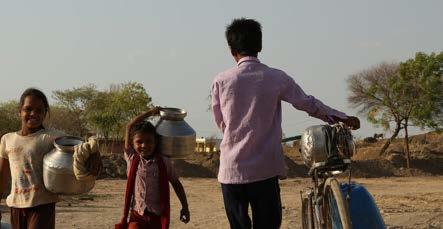
https://essaypro.com/blog/2012-end-of-the-world
An article from the Carnegie Endowment for International Peace served as a cornerstone of literature that guided the research documented in this book.
The scope and costs of this assault can no longer be ignored. They have been documented in a succession of stark reports from the United Nations and private groups like the World Wide Fund for Nature.11 On nearly all indicators, the trajectory is dismal. Global carbon dioxide (CO2) emissions would need to drop 45 percent by 2030 to hold the rise in average global temperatures to 1.5°C, the objective to which nations agreed in Paris in 2015. Instead, they are on track to decline only 3 percent by the end of the decade, portending a future of searing heat, raging wildfires, acidifying oceans, violent storms, rising seas, and mass migration.12 In the latest Emissions Gap Report, issued shortly before the twenty-seventh Conference of Parties to the UN Framework Convention on Climate Change (COP27), the UN Environment Programme (UNEP) admitted that there is “no credible pathway to 1.5°C in place.“ Indeed, current policies point to a world where temperatures rise 2.8°C, and national commitments (even if fulfilled) would only reduce this to 2.4 2.6°C.13 “We had our chance to make incremental changes, but that time is over,“ warns Inger Andersen, UNEP’s executive director. “Only a root-and-branch transformation of our economies and societies can save us from accelerating climate disaster.“14
Climate change, moreover, is just part of Earth’s environmental plight. Biological diversity is also imperiled, and global warming is not even the primary culprit.15 Around the world, ecosystems and species are at risk of collapsing as humans degrade and despoil landscapes and seascapes, dump pollutants and toxins into the environment, introduce invasive species, and harvest timber, fish, wildlife, and other living resources unsustainably.
The figures are sobering.16 Three-quarters of the planet’s ice-free terrestrial surfaces and two-thirds of its marine environment have already been severely altered, including by agriculture, ranching, logging, mining, urbanization, and industrial fishing.17 Ninety-three percent of global fisheries are overexploited or exploited to capacity, and fleets have reduced large ocean fish to 10 percent of their preindustrial numbers.18 Every year, the world discharges another 300 400 million tons of toxic sludge, heavy metals, and industrial poisons directly into the water, as well as 14.3 million tons of plastic into the oceans.19 Globally, fertilizer runoff has created more than 400 hypoxic (low oxygen) coastal “dead zones,“ with a combined area larger than that of the United Kingdom.20 One million animal and plant species face near-term extinction.21 Since 1970, populations of wild vertebrates have declined by 69 percent and insects by 45 percent worldwide, and 3 billion birds have vanished from North America.22 Humans and our domesticates now account for 96 percent of the planet’s mammalian biomass; 70 percent of all birds are poultry.23 Half of all tropical forests have been destroyed since 1960, and each year the world loses another 3.36 million hectares (8.3 million acres) an area the size of Belgium.24 Globally, more than 85 percent f wetlands and 35 percent of mangroves have already been lost.25
There have been five mass extinctions in Earth’s 4.5-billion-year history. Mounting evidence suggests we are on the cusp of a sixth.26 This risk is particularly acute in the world’s oceans, which are warmer than they have been in recorded history and 30 percent more acidic than they were just 200 years ago the fastest change in ocean chemistry in 50 million years.27 Half of all coral reefs have disappeared since 1990, and 90 percent of those that remain are likely to die by 2050 as average sea temperatures exceed those ever recorded.28 Acidic waters, meanwhile, threaten the survival of zooplankton and invertebrates and the collapse of entire food chains. Without swift and dramatic steps to reduce greenhouse gas emissions, two Princeton University scientists warned earlier this year, the loss of ocean biodiversity over the next three centuries could rival the Permian Ex-
tinction, which saw the disappearance of 90 percent of ocean life.29
Our own species is suffering, too, on this degraded and crowded planet. Hundreds of millions face food insecurity, and agricultural production must rise 50 percent by mid-century to meet growing demands.30 Freshwater resources are under similar strain as snow pack melts and aquifers are drained faster than they are replenished. By 2050, 40 percent of humanity could confront severe water stress.31
Human health is also at risk. Since 1970, some 200 pathogens have leapt from wild animals to people, often through intermediate hosts. They include among others HIV/AIDS, Ebola, SARS, Nipah, West Nile, MERS, H5N1, monkey pox, and of course SARS-CoV-2, the virus that causes COVID-19 and that came from horseshoe bats.32 While epidemiologists debate the pandemic’s proximate origins (natural transmission versus laboratory leak), they agree that we have entered a new era of infectious disease and that our unsustainable approach to nature is partly to blame.33 As humans and livestock encroach upon and disrupt biodiverse ecosystems, they encounter once-isolated species, exposing themselves to new viruses that can quickly spread globally.34 The average annual cost of emerging zoonoses is more than $1 trillion worldwide, with periodic pandemics capable of inflicting severe damage (in the case of COVID-19, as much as $28 trillion in lost global growth through 2025).35
Two and a half centuries after the much-maligned Thomas Malthus published his Essay on the Principle of Population, the good reverend merits another hearing, albeit with a twist.36 While Malthus may have erred in arguing that food production could never keep pace with human fecundity, overconsumption is definitely an ecological problem. According to the Global Footprint Network, it would take almost five Earths’ worth of resources for the world’s 8 billion inhabitants to achieve the same living standard average Americans enjoy today.37 And things are poised to get worse before they get better. Despite declining fertility, the human population will not plateau until at least 2060, and the aspirations of a rising global middle class will exacerbate ecological strains.38 Contrary to the beguiling claims of techno-utopians, there is scant evidence that societies get “more from less“ as they become wealthier.39 Rather, the newly prosperous tend to outsource their natural resource demands to developing countries.40
In seeking to satisfy these appetites, we risk breaching several planetary boundaries including those related to atmospheric CO2 concentrations, ocean acidification, species extinction, and nitrogen fixation that define what scientists call a “safe operating space for humanity.“41 Indeed, evidence is mounting that important subcomponents of the Earth system could be approaching critical thresholds that, when crossed, bring about massive, nonlinear shifts that will themselves accelerate climate change, with disastrous and potentially irreversible consequences for nature and humanity.42 Such potential discontinuities include a rapid die-back of the Amazon rainforest, abrupt melting of boreal permafrost, and the sudden collapse of the Atlantic Meridional Overturning Circulation, an oceanic conveyor belt that keeps Europe’s climate temperate.43
Short of an alien invasion from outer space, it is hard to imagine any threat warranting more global solidarity and collective action than the prospect of rendering the sole planet we have uninhabitable. Our circumstance cries out for a “present at the creation“ moment, akin to the flurry of international institution-building that followed World War II.
“Short of an alien invasion from outer space, it is hard to imagine any threat warranting more global solidarity and collective action than the prospect of rendering the sole planet we have uninhabitable.”
The Institute of Economics and Peace estimates that, by 2050 1.2 Billion people will be displaced around the world due to climate change and related disasters. If the global population reaches 9.9 billion by 2050, that means 12% of the world will be climate migrants, living on a planet with uninhabitable regional dry zones and increasing gentrification.
We must address climate change, preserve ecosystems, and promote sustainable development. By working together and prioritizing environmental stewardship, we can build a better future for humanity and the planet.
Now is the time for action.
Among the most vulnerable to these changes are agrarian communities - farmers, fishermen, loggers - whose livelihoods come from ancestral geo-engineering practice and have been intricately tied with nature for generations. For these communities, climate events are seasonal, and hence climate adversities are recurrent. If we draw a timeline it looks something like this
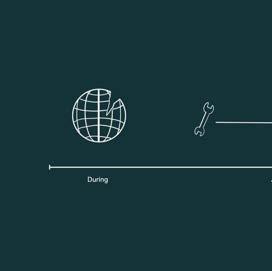

Due to the combination of repetition and unpredictability, it becomes challenging for governments to allocate resources effectively, both for infrastructure and healthcare, addressing both physical and mental health needs. Additionally, mental health issues often carry a significant stigma within these communities.

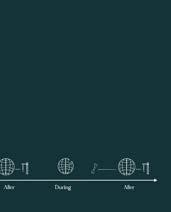
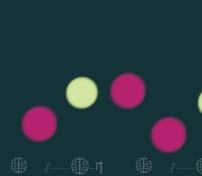
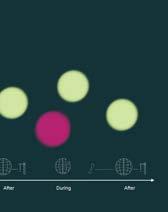

Therefore, it is not solely the result of human and infrastructural forces but also the gradual toll on individuals’ minds and bodies without respite that drives families to migrate away from their societies.
However, they do not migrate for or toward opportunity but out of necessity because their homes were destroyed, occupations disappeared, and wealth drowned. The increased occurrence and prominence of climate crises are generating both active and passive distress among humans. Since harvest is highly dependent on climate conditions,

climate change is intricately woven into not just the occupational but also the socioeconomic and personal state of these individuals, societies, and countries. In many cases, entire communities have vanished from their original landscapes as a consequence.
The connection between recurrent climate events, mental health, and children may seem loose to some; initially, it felt very loose to me as well. Until I read Rob Nixon’s Slow Violence and the Environmentalism of the Poor. Rob coined the term Slow violence to bring to attention the insidious, longterm harm inflicted by environmental degradation, socio-political injustices, and systemic inequalities that often go unnoticed or are overlooked in traditional notions of violence.
But to really understand where slow violence manifests itself, we need to also look at the preparedness and relief together.
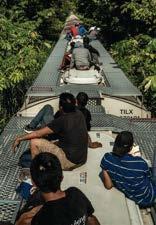

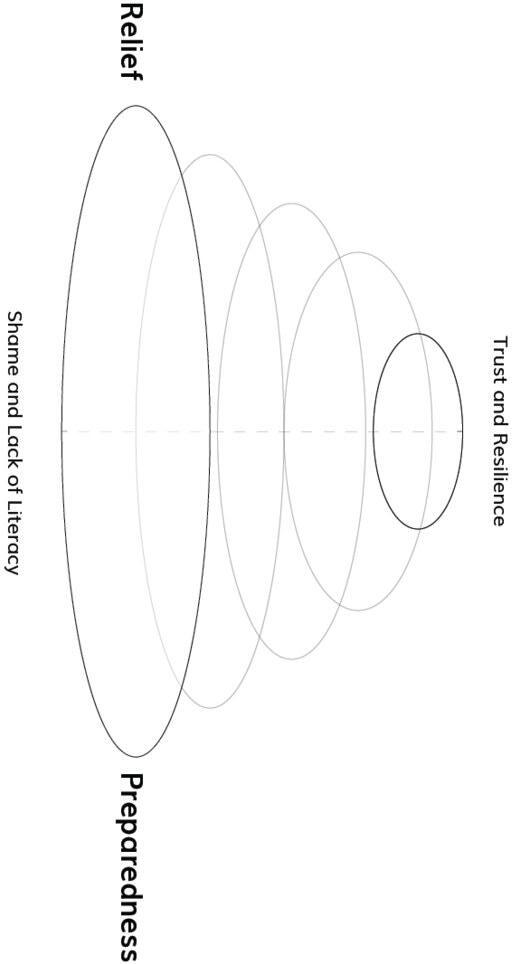
The first 3-4 weeks of my thesis semester were dedicated to researching how agrarian communities prepare for recurrent climate events. To my surprise, there was heavy documentation on schemes, plans, and even bsiness models around what should be done, but not many instances where these schemes, plans, and business models were implemented. My first understanding was that there was not enough funding, or the idea could not be scaled, or there was exploitation involved. However, the issues were related to adoption, from language barriers to distrust in something working, to failed projects as they could not provide consistent relief.
However, I did see that relief was getting a lot more attention and support from both government and non-profit organizations. But here also there is a layer of distrust, because of political and economic reasons. There’s the initial period when a community is struck by climate events, followed by a subsequent phase dedicated to rebuilding, restoring, and returning to what experts in the field term the “pre-crisis state.”
Yet, for numerous communities in the Global South, climate events are intricately woven into the fabric of the harvest season. Consequently, their timeline takes a different shape, resembling more of a continuous cycle, where the period between each catastrophe, though not immediate, becomes a state of “before.”

When in conversation with Vijay Konda, Founder of Hope Foundation, Hyderabad, India, It became clear that we cannot see preparedness and relief as separate entities; there needs to be a bridge that connects these two and the bridge to reduce the distance, in order to accommodate the increased frequency of climate activity.

Konda Vijay Kumar, Chairman Hope Foundation, Telangana.
Vijay Konda is associated with the Hope Foundation, a non-profit organization based in Hyderabad that works to provide support and services to underprivileged communities. In a quoted statement, Vijay Konda shed light on the Hope Foundation’s approach when working with tribal communities, suggesting that he likely holds a position overseeing or coordinating the organization’s outreach efforts and engagement with these marginalized groups in the region. He emphasized that in many of the tribes they serve, the organization is not directly involved; instead, a volunteer from within the tribe becomes a mediator between the Hope Foundation and the community. The approach described by Vijay Konda underscores the organization’s emphasis on patience, cultural sensitivity, and a deep understanding of the unique challenges and dynamics within these marginalized communities. By fostering trust and working through local intermediaries,
the Hope Foundation aims to deliver its services and support effectively while respecting the cultural identities and autonomy of the communities they serve.
Q: Have you seen an increase in migration due to climate change?
A: We have seen more and more people wanting to move to gentrified areas as climate adversities increase.
In India, where every few miles people, cultures, languages, and communities change, impacts of climate change are more adverse, as communication becomes a problem. At Hope, we mostly service tribal communities who are often unaware of what is coming ahead as they are locked away from news and everyday communication and stick to their own societies. Now, due to all of this, when a flood or a storm hits, they are underprepared, and even if they are prepared, they are not prepared to face the adversity of today, as for them, their little world has not changed. So at Hope, we aim to educate and empower through knowledge and help these communities be prepared.
Q: What kinds of communities are most at stake?
A: Most definitely, communities who are directly linked to the climate are very much at stake. We service a range of communities, including loggers, forest tribes, fishermen, and more. We see that over the last few years, there has been a significant shift in their lifestyles, from the food they eat to the kind of shelters they live in. Before, when the climate wasn’t so adverse, the sustainable lifestyle they built or had for generations was able to serve them, but it is no longer serving
them. Rains are stronger, winters are colder, and summers are hotter, and their ancient practices, which helped them survive, were not aiding them anymore. Moreover, we see the pattern becoming more and more common in communities when joint families are becoming single-family nexuses.
Q: What does it take to build trust and foster relationships with these communities?
A: As you can imagine, tribal communities are not synonymous with other communities and don’t easily open up, so this makes extending help and facilities very difficult. The way we work is by letting one or two people from their community approach us and make ourselves visible. Through this, we build volunteership, and this volunteer becomes the representative of that tribe, who lets us know. And this isn’t some covert operation. In many cases, the volunteer is a known important public figure from this community, who seeks permission from the community or the elders of the community. We make friends with the local rural/tribal residents and choose one or two young boys and girls to know the situation in their area from time to time, and we will take nutritional supplements, medicines, educational materials, blankets, water filters/motors, and many more resources which will help the pregnant women, malnourished children, students, elderly people, and a few more tribal residents.
Q: How are you prepared to help these communities prepare?
A: Firstly, we always prepare 4-8 months in advance. We foresee certain issues that have been a pattern in the past and therefore stock up our inventory. Ever since COVID, we have made it a structured part
of our team’s work to follow the PRE approach: P - Planning, R - Resources, and E - Executability. With these three in mind, we coordinate.
Q: Is relief accepted without any resistance?
A: Absolutely not. As a team, we faced many challenges from police, village authorities, religious groups, forest officials, nature, and many more. People think differently, but we make sure we stand by our core values – no discrimination based on religion, region, caste, age, gender, social/financial status, color, height, weight, and education. As we are a little aggressive team for work and result-oriented, sometimes we are seen as local rebels. But once they see our work and get to know us deeply, people like to join us for future work. However, the communities see this rebelliousness as allyship, and in a way, it breaks the barrier. It’s not perfect, but it’s what it takes.
Q: What, according to you, will bridge the gap between being prepared and the relief that is required after, to help these communities stay and rebuild?
A: I see a gap in infrastructure definitely, but from my work, it’s also very bold. Being prepared today encompasses a range of things, from getting your environment prepared, then your home, but most importantly, one’s body and brain. The reason why moving is seen as a viable solution is that they don’t want to put themselves, and most of all their children, in the kind of bodily stress individuals are already facing. That’s why a logger today does not want his son to continue the heritage.
While active efforts are made to counteract the visible violence, employing technology and efficient ways to rebuild and restore swiftly, the emotional distress of these communities continues to accumulate.

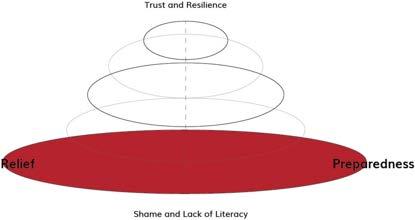
Slow violence builds anxiety and stress within the physical environment, and consistent exposure to stress creates a flight or fight response within the brain. Human experience is individual and impacted by a multitude of intersecting factors that affect the biological development; the brain, which is the mediator between the environment and biological processes, becomes disordered by trauma and maladapts, and it is unpredictable how an individual will manifest the maladaptation.
Neuroplastic changes have lasting effects on brain communication, functioning, and behavior. Being continuously exposed to stress puts the body in a flight of fight mode. During which the brain in a maladaptive method of self preservation triggers the cortico-limbic release of glutamatea chemical that greatly impacts behavior because of how it stimulates changes in neuroplasticity. Neuroplastic changes have lasting effects on brain communication, functioning, and behavior. Which is further translated to the body.
And the lack of support structures puts the brain into thinking that the individual cannot rely on anything, hence eroding the trust towards structures in one’s brain. Since that maladaptive network of not trusting is already formed - the maladaptive neurons which wire together will maladaptive fire together.
Stress is a physiological reaction that is part of the body’s innate programming to protect against external threats. When the brain anticipates danger, it triggers the stress response, releasing cortisol and activating the body’s sympathetic nervous system, which initiates the fight or flight response. This leads to the release of counter-response hormones as well, resulting in increased heart rate, accelerated breathing, dilation of blood vessels, and elevated blood sugar and glucose levels.
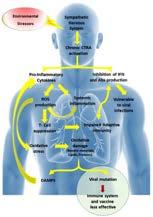
The immune system also responds to promote quick healing. However, for unremitting stress caused by slow violence, which accumulates over time, the regulation becomes inequitable and continuous.
The constant strain interlaces and accumulates in the body as it strives to return to “normal,” eventually wearing it down. Professor Arline T. Geronimus first coined the term “weathering” to describe this continuous “high-stress coping,” which is experienced as a universal human physiological process. Stress can fundamentally alter the body on a cellular level, as noted by Dr. Glenn Schiraldi.


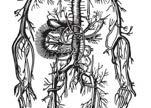

But the weathering - Like the tree, the body remembers
Children are the most vulnerable in this state of slow crisis. Unlike adult brains, children’s brain anatomy is still developing and is naturally neuroplastic[]. Even a single instance of stress can create a larger number of maladaptive neural connections -leading to altered neural circuitry.
Moreover, prolonged exposure to stress hormones like cortisol can disrupt the development of neural connections, particularly in areas of the brain responsible for emotional regulation, cognitive function, and stress response. This dysregulation in the brain’s communication is a common indication of PTSD. Slow violence is so insidious that it can manifest in the womb, A washington post article, which I came across during my research explained how cortisol released into a the womb by the mothers body had changed the structure of placenta, as the cortisol is transmutable through the bloodstream. Once again - stress can change the body on a cellular level, changing the structure of the epigenetic markers. These changes are imprinted onto how the body - which is a large system of wires which communicate with each other - speak within and develop.
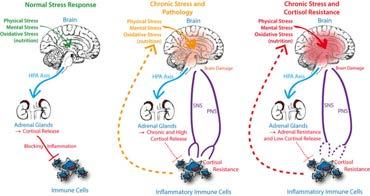
Stephanie Foo, in her memoir “What My Bones Know,” confronts the history of abuse in her ancestral line, which she had inherited.
“We are all products of our history... I don’t really think it’s surprising that we carry our fears, traumas, ties, and insecurities and pass them on to children to some degree,” she also added a personal anecdote, speaking of her greatgrandfather who had survived World War II. “I personally believe that because my great-grandmother and grandmother had to hustle desperately to survive, that has contributed to the hustle and creativity I’ve possessed in building my own career and survival skills... It’s probably contributed to my intense anxiety.

The kind of traumatic experiences faced by children are called Adverse childhood experiences.Furthermore, ACEs can also impact the architecture of the brain’s limbic system, which is involved in processing emotions and memories. This can lead to heightened emotional responses, including anxiety, depression, and hypervigilance.

Over time, these maladaptive neural connections can contribute to a range of negative outcomes, including mental health disorders, substance abuse, and physical health problems. Therefore, addressing ACEs and providing support and intervention early in life is crucial for mitigating the long-term impact on neural development and promoting resilience in affected individuals.

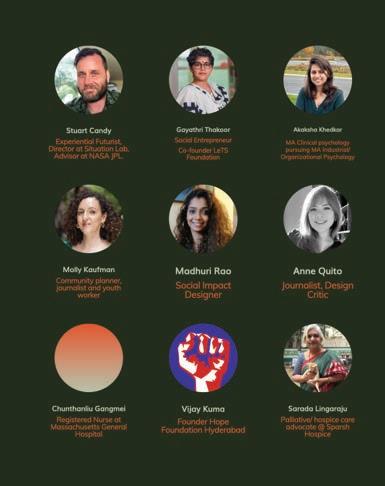
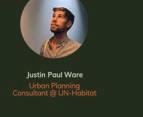

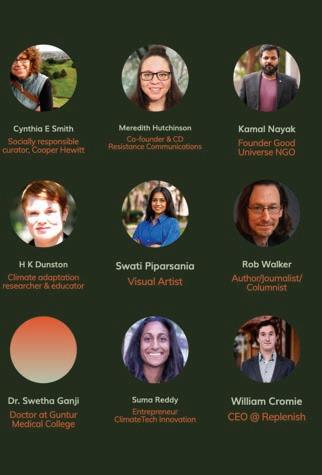

Gayathri Thakoor, Social Entrepreneur and Co-Founder LeTS India.
postgraduate degrees in Education (IGNOU) and Finance (Mumbai University), and a Bachelor’s degree in Economics.
Q. How do you think climate adversities affect children today? How does it affect them psychologically?
Gayathri Thakoor is a social entrepreneur who co-founded the Learn Through Stories (LeTS) Foundation, a not-for-profit initiative aimed at disseminating the Learn English Through Stories framework developed at IIT Bombay. With a background in academia, industry, and media, she has expertise in bridging gaps between these sectors. Previously, she contributed to the development of the Learn English Through Stories model at IIT Bombay’s Tata Centre for Technology and Design. Thakoor has managed multiple research projects, fostered collaborations, and served as a liaison between institutions, agencies, and partners. She is also a published author and co-founded ‘Nanogems’ to create children’s literature and copyrighted animated characters. Early in her career, she worked as a journalist covering diverse beats like business, crime, education, and politics for The Times Group. Thakoor holds
As someone deeply involved in children’s education and well-being, I am increasingly concerned about the profound impact that climate adversities are having on the younger generation. The effects of climate change, such as extreme weather events, rising temperatures, and environmental degradation, are not just physical threats but also have farreaching psychological consequences for children. From an early age, children are becoming acutely aware of the dire state of our planet, whether through personal experiences of natural disasters, education about environmental issues, or the constant barrage of news and media coverage. This awareness can lead to a sense of eco-anxiety, a deep-rooted fear and worry about the future of our planet and their own well-being. Children may experience feelings of helplessness, anger, sadness, and even depression as they grapple with the enormity of the climate crisis.
However, the real issue is that children are developing this anxiety from two sources: parents and social media/ communication. When my child was 6-8 years old, we experienced a flood, but I did not worry about her well-being because I trusted her resilience and my ability to keep her safe. Nowadays, due to these two factors, we see a stark difference in how parents communicate with children. The minute a parent sees a weather forecast, children are made to stay home,
alarm calls go out, and naturally, children, with their flexible brains, store these as voluntary responses to such news.

Q. Is education a route that can be pursued for this? Why is storytelling an effective tool for education? And why is LeTS rooted in storytelling?
A. No matter how much education we provide and try to build emotional resilience through information, there will be a gap, mainly because education is just a part of their day. We need interventions that can instigate them to communicate, think, and visualize differently the situation they are in. Where education can really help them is to express and reinforce the learning, because learning is never individual; it occurs in groups.
Educating a community or class is far more effective when the learners can relate to what is being taught. Many subjects and concepts are lost or tend to be feared for years when there is no context or relevance shown.
A teacher is revered as a good educator when they deliver the concepts in ways that can relate to the learners, so they make it their own. Experience tells us that a lot can be achieved through storytelling. A professor in food science I know once said, “A good teacher is one who can tell the most wonderful stories.” That the concepts can be woven into stories and then delivered to the captivating learners, for them to absorb, contextualize, internalize, and always remember, is what makes teaching and learning even more impactful.
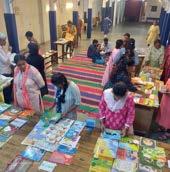
Another critical aspect of our process is that as learners gather the means to generate their own content – and, especially, as they put it together – their own lived worlds and realities become part of the learning material, from language to geography, science to story. They write themselves in.

The development of children is influenced not only by internal factors but also by the responses of adults, which play a crucial role in shaping their growth. When in conversation with Gayathri Thakoor, Social Entrepreneur and co-founder of Learn Through Stories (LeTS) Foundation, India, she spoke about how parents of the 2000s are extremely concerned about their children when they are not at home. She shares a personal anecdote, stating that over the last 10 years, childcare has shifted from allowing children to learn and grow through making mistakes and facing challenges to a focus on protection, supervision, and constant monitoring.
“As a parent, when my daughter was in elementary school, I never panicked about her well-being to the extent of needing to make alarm calls or inquire about her minute-to-minute status. Even during floods, we trusted that our child would return home safely. We were concerned, yes, but not like parents today who, upon hearing a hurricane warning, immediately call to check up on their kids,” she added.
She also noted how technology has made it very easy to make alarm calls, and while parents may believe they are safeguarding their children, the children perceive these calls as signals of danger. This erosion of trust between parents and children is concerning.
While technology has its perks and solutions, it also has created a web of lacking trust within individuals, which has to be addressed.
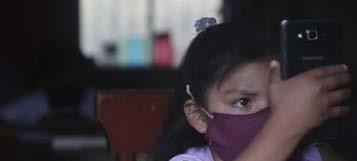
During this conversation, there were three large themes - Trust between parents, children, and their environment is deficient, influencing children’s learning of crucial responses, reactions, and information processing primarily through parental influence.
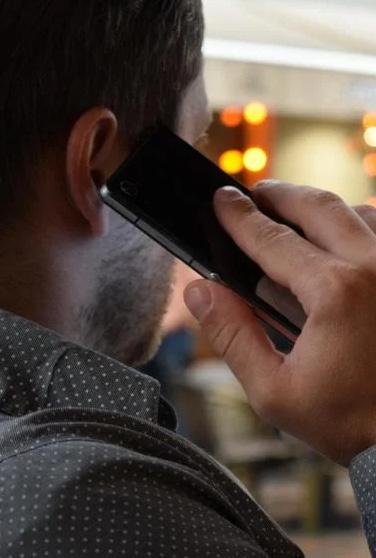

Cynthia E. Smith, Curator of Socially Responsible Design Cooper Hewitt
Smithsonian Institution
Cynthia E. Smith is the Curator of Socially Responsible Design at Cooper Hewitt, Smithsonian Design Museum. In her role, she organizes exhibitions, publications, and public programs exploring the evolving field of design aimed at addressing global social issues. Smith’s curatorial work has focused on showcasing how designers, architects, engineers, and non-profits collaborate with communities to co-create solutions that improve lives and alleviate poverty. Her notable exhibitions include “Design for the Other 90%,” which highlighted designs for underserved populations, and “Design with the Other 90%: CITIES,” examining informal urban settlements. Smith’s curatorial vision extends beyond developing economies, exploring the intersection of poverty, prosperity, and design innovation within and beyond the United States as well.
Q: As the curator of Socially Responsible Design, how do you evaluate whether a project fits within the theme, especially a theme like designing for peace?
A: I would say that it starts with developing a thesis. That’s the first thing I do - put together a thesis to organize the initial research, talking to people, and gathering information, not unlike what you’re doing. So you have this guiding statement, and then you go out and conduct extensive research. I cast a wide net, trying to talk to as many people as possible, and they lead me to more projects and work. Then I begin to sort through what I’ve gathered because I’m looking at current happenings or concepts that people are envisioning. Often, themes start to emerge. I don’t go out looking for specific themes initially. I just have a broader question or proposition. And then, as I begin to analyze the research, the themes sort themselves out. I bring it to other people to see if it makes sense because I’m always thinking about who my audience is. Depending on the work, I have different narratives and scales because I only have a limited exhibition space. So I tell stories using different media, depending on what’s available based on the work of that particular designer, artist, or collaborator. It has to be legible and make sense.
This is the dilemma we’re living in right now. This is what we’re thinking about in the degrowth movement, when you consider degrowth, we’re at a point where the planet’s future is at stake. When you talk about your kids’ future, are you thinking about profit? Probably not. We’re likely talking about social entrepreneurship because it depends on who the population is and who’s working
in that arena.
You have to look at the different sectors - public, private, and civil. So you really need to think about whether it’s a municipality or part of what a government will deliver at the local level. Or is it a neighborhood group? A non-governmental organization (NGO)? A combined effort? An agency? It depends on the country, its economy, and whether you’re an international upstart wanting to crowdsource and create something.
We have the ability to stop this warming if we choose to do so. I want to introduce you to someone because I think you’ll have a fabulous conversation with them, and they’ll point you to things I could never, as this is directly what they’re looking at. It’s an initiative called “Root Shock 2.0.”
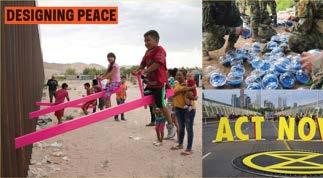
Q: From the work you’ve done and the artists you’ve seen and collaborated with, what do you think the planet will look like? It was definitely different from when you were young.
A: There is definitely a difference, and that difference calls for action, which is what you’re looking at in relation to what’s happening. We’re on the brink of it exploding all over the place with the advent of a warming planet. If we don’t achieve zero emissions, we’ll be unable to inhabit large portions of the Earth, leading to mass migration.
The original “Root Shock” influenced an entire generation of city designers and urban designers. It was a really important book. The other thing I want you to look at is the IPCC, the Intergovernmental Panel on Climate Change. There are some graphs you might want to include in your thesis, which really show what the planet is going to look like for people born when I was born, people born 20 years later, and people of your age and later, if we don’t do something now. It will lend credence to your argument.
In children of low and middle income agrarian households, we see an increased tolerance towards climate events, but the vulnerability is compensated when handling issues of slow violence brought on by the climate event - alcoholism in parents, parental absence, strict/stern parenting, emotional and physical abuse, and in some extreme cases death of a parent through suicide.
Following such events, the brain looks for physiological ways to express what cannot be tolerated to articulate making somatic symptoms and conversion disorders common byproducts of PTSD .
Trauma impacts the brain’s neurobiological responses or otherwise manufacturing processes- how it communicates with the rest of the body Traumatic events are held by the brain with more complexity and enmeshment than benign or even positive ones (Corrigan & Grand, 2013) [12]. Dissociation first presents during traumatic events and is the first association of how that memory becomes held. It is the foremost coping skill the brain develops- it exacerbates other symptoms and creates great complexity in the treatment process. Colloquially known as shock, dissociation is a prolonged state of being during which one feels detached from their emotional state and physical self, a maladaptive attempt at self-preservation.
Trust is the generalized expectation that they themselves or another individual can be consistently relied upon, without any harmful repercussions.
the feeling/ emotion attached to being in a reliant space or with a reliant person.
One of the primary challenges faced by low-income societies living in climatealtered environments is the unpredictability of relief efforts. Despite the increasing frequency of climate-related disasters, the response remains inconsistent and often delayed, leaving residents grappling with uncertainty about when or if help will arrive. This lack of reliability erodes trust in relief structures, leaving communities feeling abandoned and neglected. Furthermore, even when aid does reach affected areas, the accountability of relief efforts comes into question. Reports of mismanagement, corruption, and misallocation of resources are not uncommon, exacerbating the distrust towards relief organizations and government agencies. Without transparency and accountability, vulnerable communities are left susceptible to exploitation and further marginalization.
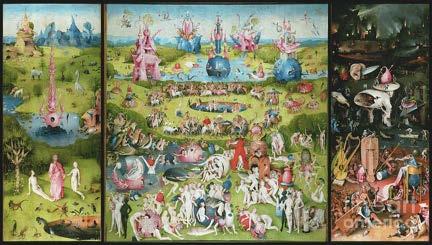

Mallela Prashanti, Indian Administrative Services Officer, for the Telangana state.
Mallela Prashanti, graduated in Economics from Osmania University, Hyderabad, India. She holds a PG degree in Political Science and M Phil in International Relations from the University of Hyderabad, India. She was selected in the Indian Administrative Service and is currently working as an Additional Secretary in the Department of Environment Forest, Science & Technology in the Government of Telangana. She also holds additional charge of the post of Director in the Department of Health, Medical & Family Welfare looking after the division of traditional medicines like Ayurveda, Homeopathy & Naturopathy.
She previously worked as a District Magistrate of a district primarily consisting of a rural population occupied in agricultural operations. She took the initiative to develop an App designed to enable small farmers in rural and remote areas to access Agricultural machinery on the uber model. This project went on to win a National award.
As Director of the Department of Women & Child Welfare, she successfully conducted skill development programs for rural women, many of whom were successfully placed in the market.
Q. In your term have you seen migration and what have your and the government done to support the movement or help them rebuild?
A. As someone who has been closely involved with initiatives in Telangana, I can speak to the efforts made by the state government to support communities affected by diminishing natural resources. Despite having a rich heritage in cattle, textiles, and art, natural resources have become increasingly scarce over the years. This has led to tribal communities, villagers, and artisans migrating to towns and cities, causing them to abandon their traditional practices. Early on, we recognized the need to subsidize these artisans, farmers, and tribals to help them earn a decent living from their crafts. When they move to cities, they often face financial exploitation,

social marginalization, and in the case of women and young girls, even sexual exploitation. To combat these issues, we initially focused on forestry and tourism initiatives. In recent years, the emphasis has shifted towards water, energy, and infrastructure development, including housing, ensuring access to clean water, and providing produce and fertilizers for farmers and fishermen, primarily through loan programs. Moreover, to empower women in this process and reduce violence against them, a significant portion of land and loans are subsidized for women, making them the primary decision-makers. As a government, our approach is to keep people rooted in their communities and build infrastructure to support their livelihoods there. The more migration occurs, the more the state’s overall well-being diminishes, a factor that many states fail to consider. Unlike highly industrialized states that may seem to profit from migration, even their gains become difficult to sustain. When societies dwell in a place, they promote water conservation, greenery, and the preservation of natural habitats, as humans have historically been accelerators of environmental stewardship. It was not until the rise of the fossil fuel industry that this balance was disrupted.
However, lacking the means or, in some cases, the cultural inclination towards institutional education, they encourage their children to enter the labor market and earn money instead. This situation is absolutely atrocious, but it is the reality we are grappling with. There was a case involving girls from Orissa, rural tribals who had migrated almost 50 miles away. We found them at a construction site on the border of Telangana, being exploited to the point of earning a mere 10 rupees (0.12 dollars) per day.
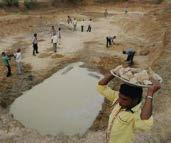
Q. What are some issues the government has seen rise in the last few years due to migration?
A. A significant issue we face with migrant communities is the violence and exploitation of children. While I do not want to attribute it solely to climate adversities, the challenges arising from such adversities play a role. Parents in these communities often desire a different future for their children than the one they have experienced.
We intervened, providing these children with counseling, medical assistance, and facilitated their return to their original villages, offering incentives for education and monetary benefits. However, two seasons later, they were back in the same exploitative labor market. This is where, as a government, our services alone are not enough. That is why we provide funding for non-profits, self-help groups, and various committees whose mission is more localized and impactful, as they belong to those very communities. Their grassroots approach is crucial in addressing these deep-rooted issues effectively.
M. Prashanti, IAS, the Joint Collector, Hyderabad District formerly the Director and State Commissioner for the Welfare of Disabled and Senior Citizens, Govt. of Telangana and Joint Secretary to the Govt. of Telangana State, who has served as the former collector of Nirmal district, in the state of Telangana speaks to how in the state of Telangana, drought relief efforts have shifted focus towards supporting small communities and societies through policies and schemes. Despite these measures, the toll on mental health within these communities cannot be overstated. The constant threat of disaster, coupled with uncertainty and distrust towards relief efforts, creates a pervasive sense of anxiety and despair.
Moreover, generational injustice has led to a history of mistrust towards outsiders. Therefore, the government has been providing support to locals, often through trusted individuals, to act as beacons of change within their communities. However, communication barriers hinder government initiatives in reaching small societies.
Addressing the trust deficit in relief structures requires a multi-faceted approach that prioritizes transparency, accountability, and community engagement. Relief organizations and government agencies must work collaboratively with local communities to develop solutions responsive to their needs and concerns, establishing clear communication channels and ensuring equitable resource distribution.

Efforts to build resilience within these communities must extend beyond physical infrastructure to encompass mental health support and psychosocial services. Providing resources for coping mechanisms, trauma counseling, and community-building initiatives can help alleviate the psychological burden of living in a climate-altered world.

It becomes evident that climate-induced slow violence affects not only the mental and physical state of a child but also familial, social, cultural, and possibly even genetic aspects. This realization drew parallels with my senior Erika Choe’s thesis.

A portion of mythesis took inspiration from my Senior’ Erika Choe’s Thesis, which focused on the preserving humanness in the world shifting towards cohabitating with technology. While her thesis is wholly dedicated to exploring how humans currently interact and will interact with technology, mine also delves into how technology can intervene to a certain extent, with her thesis serving as a guiding beacon.

But, a major theme that emerged for me as a reader of her thesis was the concept of trust. If we can first instill trust in individuals living in potential climatealtered societies towards themselves, we can begin a larger project aimed at restoring both humanness and trust within societies, whether that be through social media, digital experiences, government initiatives, or healthcare.
If we project this onto the preparedness healing helix, we will see that if trust is not built the curve will expand and if trust is built then the curve’s radius will become smaller. Towards the preparedness end we need to build resilience within individuals , therefore instilling trust in themselves, whereas on the other end - relief - design should aim to provide structure for developing dependability.




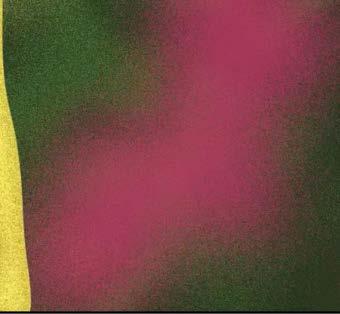

During the course of the thesis, I was constantly told to narrow my focus on users and target audience, as if this issue were a global one. Even while sitting in New York City, surrounded by technology, I couldn’t solve it. My mentors and advisors often urged me to narrow the topic as much as possible. Moreover, even on a global scale, the problem’s characteristics and reasons for its existence change every few kilometers due to the topology of the Earth, and so do what children experience. It was already September, and I reached a point in my thesis where I had to make a decision about what my thesis was addressing - policies, injustice, healthcare, or a combination of these?
Almost 2 months into headfast research in September, we had a guest speaker at PoD, Panthea Lee. Panthea Lee is a writer, activist, and transdisciplinary strategist / designer / facilitator working for structural justice and collective liberation. So far in my thesis, I hadn’t spoken to someone from the field of structural activism, because I did not think my answers lay in that space. But how wrong was I? During Panthea’s lecture, I was introduced to the possibilities and prospects of healing, what it is, how it differs from religion and activism, and the potential modalities in which we can provide healing.


Healing in the context of my thesis adapts its original definition of the process of becoming or making somebody/something healthy again; - it is the systematic process of realizing, restoring, and reinventing physical health, mental health, individual connections to themselves, group, society, or environment, that has been affected by physical, emotional, mental, or spiritual distress or harm. And its success in adoption lies in the versatility of modalities it can come in.
During her lecture, she discussed the significance of healing in a GDP-driven era, where people’s value is often assessed solely based on economic criteria, such as a country’s resource allocation capabilities.
Her words took me back to a part of Rob Nixon’s Slow violence and the Environmentalism for the poor -
“In the global resource wars, the environmentalism of the poor is frequently triggered when an official landscape is forcibly imposed on a vernacular one. A vernacular landscape is shaped by the affective, historically textured maps that communities have devised over generations, maps replete with names and routes, maps alive to significant ecological and surface geological features. A vernacular landscape, although neither monolithic nor undisputed, is integral to the socio-environmental dynamics of the community rather than being wholly externalized—treated as ‘out there,’ as a separate nonrenewable resource. By contrast, an official landscape—whether governmental, NGO, corporate, or some combination of those—is typically oblivious to such earlier maps; instead, it writes the land in a bureaucratic, externalizing, and extraction-driven manner that is often pitilessly instrumental. Lawrence Summers’ scheme to export rich-nation garbage and toxicity to Africa, for example, stands as a grandiose (though hardly exceptional) instance of a highly rationalized official landscape that, whether in terms of elite capture of resources or toxic disposal, has often been projected onto ecosystems inhabited by those whom Annu Jalais, in an Indian context, calls ‘dispensable citizens.’”
Following World War II, there was a proliferation of indices and acronyms aimed at quantifying the worth of individuals and populations, including the happiness index and GHDpe, contributing to the emergence of what she termed as a “third wave” characterized by the perception of individuals as expendable or disposable.
The wave of treating people as commodities initiated the process of commoditization and began to erode humanity from the ecosystem of human connection. Over the last seven decades, this epidemic has permeated various aspects of life, including healthcare, schooling, religion, and even childbirth. commoditization has emerged as a potent force shaping the dynamics of wealth, power, and societal stratification. Defined as the transformation of goods, services, ideas, or even people into commodities to be bought and sold in the marketplace, commoditization has permeated nearly every aspect of human existence. However, its insidious effects extend far beyond the realm of economics, seeping into the very fabric of social relationships and exacerbating systemic injustices.
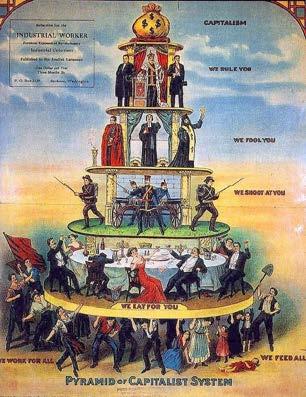
At its core, commoditization reduces individuals to mere economic units, valued primarily for their utility in generating profit. This reductionism strips away the intrinsic worth and dignity of human beings, relegating them to the status of interchangeable cogs in the machinery of capitalism. As a consequence, socialeconomic injustice thrives, perpetuating disparities in wealth, opportunity, and access to resources. The commoditization of labor, for instance, leads to exploitative working conditions, stagnant wages, and precarious employment, disproportionately affecting marginalized communities already grappling with historical oppression.
Moreover, commoditization serves as a catalyst for the proliferation of classism, erecting barriers that perpetuate social stratification and entrench privilege. In a commoditized society, one’s worth is often measured by their ability to consume and accumulate material possessions, reinforcing notions of status and prestige tied to economic wealth. As a result, those at the lower rungs of the socioeconomic such as low income agrarian households and workers find themselves marginalized and disenfranchised, locked in a cycle of poverty and exclusion.
The consequences of commoditization extend beyond material inequalities, permeating the very fabric of social cohesion and communal harmony. As trust erodes within the system, fueled by perceptions of exploitation, injustice, and inequality, the bonds that bind communities together begin to fray. The lack of trust breeds suspicion, resentment, and alienation, undermining the collective solidarity necessary for a thriving society. In the absence of trust, cooperation gives way to competition, empathy yields to indifference, and the common good is sacrificed at the altar of self-interest.

Panthea’s lecture was invigorating as it resonated with many of the concepts I had been exploring in my initial research. She briefly delved into the concept of UBUNTU, which underscores the interconnectedness of humanity and the significance of communal harmony. At its essence, Ubuntu highlights the idea that individuals are shaped by their relationships with others, and that one’s humanity is deeply intertwined with the collective well-being of the community. This philosophy advocates for empathy, compassion, and mutual respect, urging individuals to acknowledge the humanity in others and to extend dignity and kindness in their interactions.
Ubuntu emphasizes the inherent value of relationships and the idea that “I am because we are.”
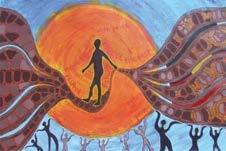
It embodies a belief that individuals are fundamentally connected to one another, and their well-being is intricately tied to the well-being of the community as a whole.
In the context of commoditization and socioeconomic injustice, Ubuntu serves as a poignant reminder of our shared humanity and the importance of fostering solidarity and mutual support within society. As commoditization reduces individuals to mere economic units and fosters a culture of competition and exploitation, Ubuntu calls for a shift in perspective towards collective wellbeing and cooperation. It highlights the need to recognize the dignity and worth of every individual beyond their economic value, thus challenging the dehumanizing effects of classism and social injustice.
Today “We are witnessing layer and layer so trauma, historical, generation, ancestral and soul deep”
Panthea’s discourse on stewarding love and liberation as a modality of activism to foster healing inspired me to explore what lies behind a successful mode of healing. At the core of this journey lie the fundamental principles of Ubuntu. However, the question arises: how can we advocate for systemic healing in a world driven by structural and economic agendas, where the concept of healing often feels marginalized and trivialized?
In contemplating the essence of healing, it becomes evident that its essence lies in cultivating resilience, a term more commonly embraced and applied within systemic frameworks. To understand this better, I conducted a concreation workshop with young adults and adults in their early 20’s. The agenda of the co creation was to have young adults envision their younger selves, in self exploration and envision what traits of resilience, they would foster in them.


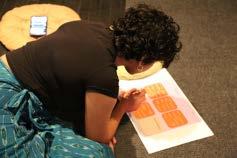
In co-creation workshop, we embarked on a journey to understand the multifaceted concept of resilience. Initially, our focus was on exploring the diverse definitions of resilience, both from individual perspectives and from a broader societal viewpoint.

For the first half of the workshop we explored the various definitions of resilience both individually and what definition the world has -
“is the ability to cope mentally and emotionally with a crisis, or to return to pre-crisis status quickly.”

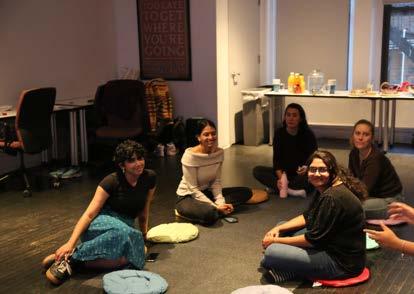

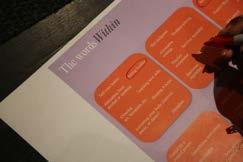
“I dont think you can ever go back to a pre crisis state“


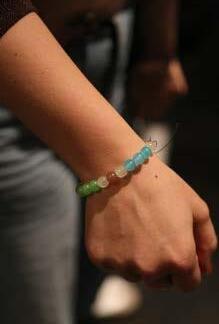

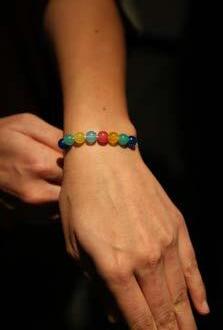



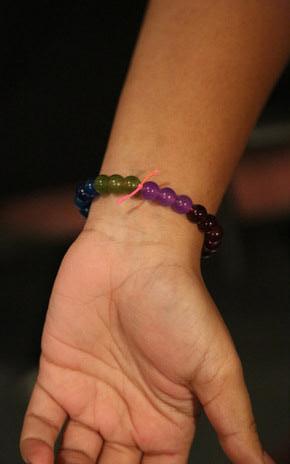




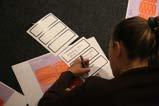

terms of attention, anticipation, encouragement, intention, and risk-taking and management both before and after an adversity they may face. Moreover, it will also aid the individual in assessing and navigating their path back to a state of “normality.”
Normality is characterized by a consistent ability to navigate through daily routines without experiencing significant fluctuations in mood or motivation. It’s a blend of cultural norms and personal discipline, suggesting that resilience necessitates a routine that aligns with an individual’s cultural background.
However, how does normality differ from the pre-crisis state? When individuals encounter adverse or traumatic experiences, their brain undergoes changes as old neural networks disintegrate and new ones form, leading to changes in how the brain perceives, processes, and stores information. Even if the individual remains in familiar surroundings and receives similar information, the brain no longer interprets it in the same way. These changes often lead to the triggering of traumatic memories associated with certain stimuli, which were previously understood
Normality during the course of my thesis, has been defined as the way to continue the same routine while accommodating cultural nuances. A balanced integration of these factors can contribute to resilience.
During the co-creation I met Akanksha Kedhkar, who is Clinical Psychologist. We got into the discussion of what are the key playbooks in building resilience.
She pointed out that in psychology, Activities of daily living or Instrumental activities of daily living are a way in which we can assess an individual’s functional status and ability to live independently. The activities of daily living (ADLs) encompass fundamental tasks necessary for independent living, such as personal hygiene, dressing, eating, maintaining continence, and transferring/mobility.
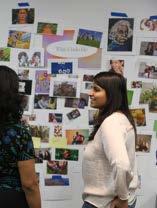

`
5
Akanksha Khedkar is an experienced clinical psychologist with a proven track record of providing comprehensive support in both hospital and educational settings. She has demonstrated expertise in delivering effective therapeutic interventions and fostering mental well-being for her clients. Currently, Akanksha is advancing her expertise by pursuing a Master’s degree in Industrial/Organizational Psychology. With this specialized training, she aims to blend her clinical expertise with an understanding of organizational dynamics, positioning herself to offer valuable insights at the intersection of psychology and the workplace. Akanksha’s background in clinical and counseling psychology, spanning five years of work experience, has equipped her with strong skills in human relations, team building, and effective communication. Her unique combination of clinical knowledge and a growing understanding of organizational psychology makes her a valuable asset for organizations seeking to
promote a positive and productive work environment.
Q. Why are routines important?
A. I cannot overstate the importance of routines for children’s development and well-being. Routines provide a sense of structure, predictability, and security, which are crucial for a child’s emotional and cognitive growth. When children know what to expect and when, they feel a sense of control and safety in their environment, reducing anxiety and promoting a sense of calm. Routines also help children develop self-regulation skills, as they learn to anticipate and prepare for transitions between activities. This ability to regulate their emotions and behaviors is essential for their social and academic success. Furthermore, routines foster a sense of responsibility and independence, as children learn to complete tasks and follow a schedule without constant reminders.
Q. Are Routines and ADL’s the same?
A. No, routines and ADLs are related but distinct concepts when it comes to child development. As a psychologist, I view ADLs as the specific self-care tasks that children need to learn and master, while routines provide the structured framework for practicing those skills.ADLs refer to the basic activities like dressing, grooming, feeding oneself, using the toilet, and basic hygiene tasks. These are the building blocks of independence that all children must acquire through patient repetition and support from caregivers. Mastering ADLs allows children to take care of their own basic needs. Routines, on the other hand, are the predictable sequences and schedules that families use to organize a child’s day and times for
certain activities. Having consistent routines creates the opportunities to practice ADL skills at developmentally-appropriate times. For example, a morning routine may involve the ADLs of using the toilet, brushing teeth, getting dressed, and eating breakfast in a structured way.
So while ADLs are the specific self-care skills, routines provide the reliable contexts and prompts for children to work on those skills. The routines support ADL learning by breaking down when and how those tasks get accomplished. Without routines, the practice of ADLs can become haphazard. But routines alone don’t necessarily teach the step-by-step process of each ADL.
Q. Are ADLs important for becoming resilient?
A. Absolutely, engaging in Activities of Daily Living (ADLs) is vital for children’s resilience development. ADLs are the basic tasks that children need to perform daily to take care of themselves, such as dressing, grooming, and feeding themselves. When children can successfully complete these tasks, it builds their confidence, selfesteem, and sense of competence. As a psychologist, I understand that resilience is the ability to bounce back from adversity and cope with challenges. By mastering ADLs, children develop a sense of accomplishment and self-efficacy, which are key components of resilience. Each time they overcome a challenge, such as learning to tie their shoelaces or brushing their teeth independently, they build resilience muscles that will serve them well in the face of future difficulties.
Moreover, ADLs often involve problemsolving skills, as children must figure out how to complete tasks and overcome obstacles. This process of trial and error
fosters perseverance, adaptability, and creative thinking – all essential qualities for resilience. It’s important to note that children’s ability to perform ADLs can also serve as an indicator of their overall development and well-being. If a child struggles with ADLs, it may signal underlying issues that need to be addressed, allowing for early intervention and support. By encouraging and supporting children in mastering ADLs, we not only promote their independence and self-care skills but also nurture their resilience, equipping them with the tools to navigate life’s challenges with confidence and strength.
Q. How do trust and shame work when viewed from the perspective of climate anxiety in children?
A. As a psychologist, I’ve witnessed how the existential threat of climate change deeply impacts children’s sense of trust and shame. Climate anxiety stems from feeling betrayed by the adults and systems meant to protect them, eroding their foundational trust in a safe world. Children internalize the idea that “the planet is dying due to human actions, and I am human, therefore part of the problem,” breeding profound shame tied to their self-worth and identity. Their malleable brains seek this association as an absolute truth. Grappling with these heavy emotions of mistrust and toxic shame, children need reassurance, validation, and a restored sense of agency. Dismissing their climate anxiety reinforces the original mistrust igniting the shame cycle. By listening, validating their perspective, and channeling it into positive action, we can help children rebuild trust, release unproductive shame, and find their voice as environmental stewards.
ADLs alone are not sufficient to build self-confidence. While activities of daily living (ADLs) are crucial for maintaining independence and well-being, they are not directly correlated with the development of self-confidence. Selfconfidence is more closely linked to one’s beliefs, attitudes, and perceptions of their abilities and worth. Engaging in confidence-building exercises, focusing on strengths, setting and achieving goals, and practicing selfcare are some of the methods for building self-confidence. ADLs provide structure in one’s daily activities, which allows time and the ability to engage in self-improvement activities.
On the other hand, culture plays a dignified role in self-confidence, in the growing ages, the interaction and interfacing with cultural activities and exposure to literature, art, music and activities rooted in culture provide a sense of identity and commonness to people, spaces, and objects. Especially in children, when they participate in family events at home and outside in their culture, they will have more self confidence - CNRS (Délégation Paris Michel-Ange).

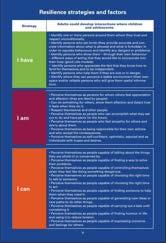
When we combine ADLs and self-confidence-building activities, we can begin to introduce children to trust-building activities within their environmentinvolving objects, people, and placing themselves in that environment.


Routines and activities of daily living (ADLs) are related but not identical. ADLs pertain to the fundamental tasks necessary for independent living, such as personal hygiene, dressing, eating, and mobility. Conversely, routines encompass a broader set of activities that an individual regularly performs, which may include ADLs but also extend to other daily habits and tasks. While ADLs primarily focus on essential self-confidence-building activities, routines involve a wider range of behaviors and actions that an individual engages in regularly.
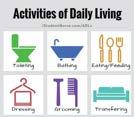
Therefore, while ADLs represent a specific subset of activities, routines are more comprehensive and can incorporate various daily practices and habits. Moreover, routines are ingrained in the body, so the flexibility of adapting to an environment can be fostered by building trust from within - inward outrather than relying solely on changing the environment.


proposing routines as a systemic structure to foster resilience in children impacted by the effects of climate-induced slow violence, particularly those living in low and middle-income agrarian communities.
Where can we introduce routines for children?
But when we draw a systemic map around the ecosystem surrounding a child, it looks something like this. The ecosystem can be split into three distinct sections: the self, immediate environment, and social structures.
27% of the earth population is Children 12.7% are experincing extreme poverty
When designing for children, we need to ensure that there is an entry from the outer circles as the self is protected by them. However, there are some considerations and constraints to keep in mind, such as parental control, how children interact with it, and cultural sensitivity. While these factors enforce safety and structure, it is also important to foster freedom to make mistakes for natural growth patterns to form.
“The act of making that designers find so satisfying is built into early childhood education, but as they grow, many children lose opportunities to create their own environment, bounded by a text-centric view of education and concerns for safety. Despite adults’ desire to create a safer, softer child-centric world, something got lost in translation. Jane Jacobs said, of the child in the designed-for-childhood environment: “Their homes and playgrounds, so orderly looking, so buffered from the muddled, messy intrusions of the great world, may accidentally be ideally planned for children to concentrate on television, but for too little else their hungry brains require.”9 Our built environment is making kids less healthy, less independent, and less imaginative. What those hungry brains require is freedom. Treating children as citizens, rather than as consumers, can break that pattern, creating a shared spatial economy centered on public education, recreation, and transportation safe and open for all.”

Hence, routines ought to be adaptable to accommodate cultural nuances, provide freedom, and flourish within the ecosystem, encompassing family dynamics, friendships, social networks, and even visitors to the environment.
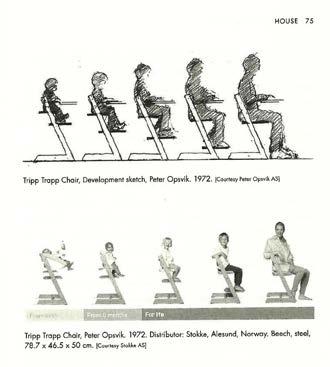
In today’s world, the influence of social media and external opinions has a significant impact on our society and the environment, both positively and negatively. When someone’s opinion on a matter of social change is shared online, they leave their digital footprint on that topic, potentially influencing the outcome of the issue.
An example of the power of digital footprint is the ALS Ice Bucket Challenge. What started as an awareness-raising campaign gained global attention through posting and reposting, ultimately spurring action. This demonstrates the potential for media and technology to facilitate widespread engagement and social change.What began as a grassroots effort by individuals affected by Amyotrophic Lateral Sclerosis (ALS) evolved into a viral sensation, demonstrating the remarkable power of digital platforms to drive change and generate unprecedented support for a cause.
The ALS Association, a US-based non-profit dedicated to funding ALS research and patient care, found itself at the epicenter of this extraordinary fundraising phenomenon. Three individuals living with ALS-Pat Quinn, Anthony Senerchia, and Pete Frates,initiated the challenge in 2014, urging participants to dump buckets of ice water over themselves, film the act, and nominate others to do the same, all while soliciting donations for ALS research. The campaign spread like wildfire across social media platforms, captivating the attention of millions worldwide. Celebrities, influencers, and ordinary individuals alike enthusiastically embraced the challenge, propelling it to unprecedented levels of visibility and engagement.
At its core, the ALS Ice Bucket Challenge exemplified the transformative potential of social media in catalyzing social change. By leveraging the viral nature of digital networks, the campaign transcended geographical boundaries and cultural barriers, uniting people from diverse backgrounds under a common cause. Through the power of collective action and grassroots mobilization, the ALS Association succeeded in raising over $100 million’a testament to the immense impact of online communities rallying behind a shared purpose.
However, the campaign’s success also underscored the nuanced dynamics of digital activism and the complexities of translating online engagement into tangible outcomes. While the Ice Bucket Challenge achieved unprecedented levels of participation and fundraising, its long-term impact on raising awareness about ALS remained somewhat ambiguous.
Despite its initial focus on raising awareness about ALS, the campaign’s narrative gradually shifted towards maximizing financial donations, leading to concerns about the dilution of its original message. Moreover, the transient nature of viral trends meant that the campaign’s momentum eventually waned, raising questions about its lasting impact on public consciousness and engagement with the ALS cause.
Nevertheless, the ALS Ice Bucket Challenge offers valuable insights for
organizations and practitioners seeking to harness the power of social media for advocacy and fundraising efforts. By prioritizing transparency, authenticity, and community engagement, organizations can cultivate meaningful connections with online audiences and leverage digital platforms as catalysts for social change.
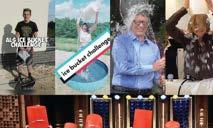


The ALS Ice Bucket Challenge serves as a compelling case study in the transformative potential of social media to drive positive change. While its legacy may be marked by both triumphs and challenges, the campaign stands as a testament to the profound influence of digital networks in shaping collective action and advancing social causes on a global scale.
Social media plays a significant role in my thesis, serving as a platform for generating accessible awareness about the trajectory of global issues. It enables individuals, whether directly affected or observing from a distance, to understand their role in driving change. However, it is crucial to acknowledge that this experience has to be owned and authored by the people who are being represented.
My curiosity to delve into the realm of journalism and photojournalism, exploring their limitations and potentials in providing a way to enhance conversation around slow violence, stemmed from Meredith Hutchinson’s workVision, Not Victim.
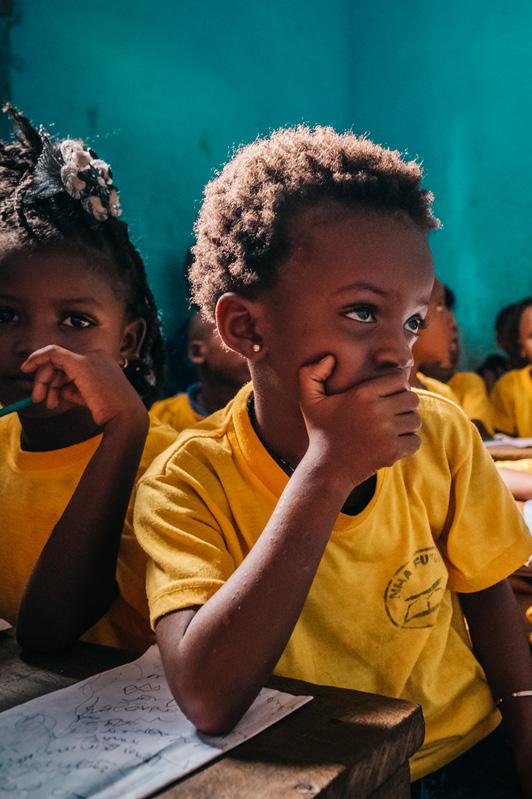
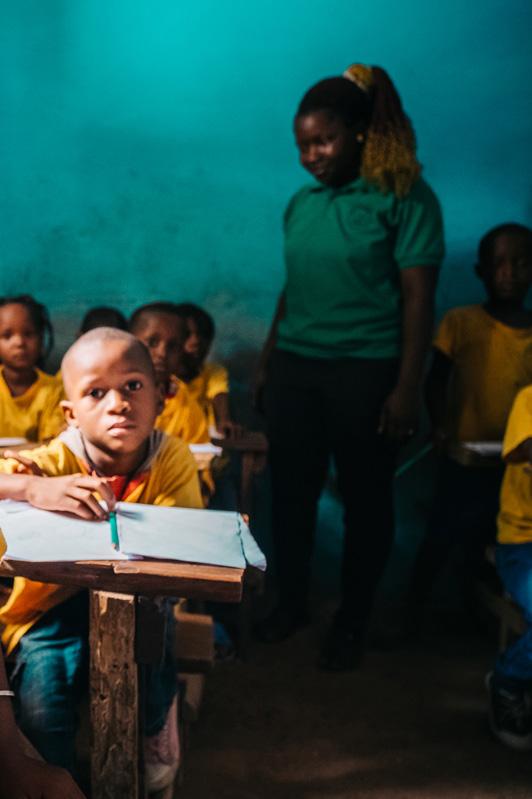

Vision, Not Victim is dedicated to empowering girls and granting them autonomy over their life trajectories, ensuring they are free from violence and have access to equitable opportunities and choices. The organization collaborates with girls, parents, and community leaders to facilitate the realization of these rights. Meredith’s work focuses on community collaboration to produce images that challenge stereotypes, dismantle oppressive systems, stimulate dialogue, and demonstrate the potential for positive change.
“being able to show people what it is that you’re trying to build in a way that is more tangible. In some sense, it’s more emotional. That in and of itself is a really, really powerful tool. And I would just add, I think that has to be done with people. It can’t be done by individual artists sitting alone by themselves. They can do it for themselves, write their own vision, and that’s fine. But if you want to talk about creating systemic change, if you want to talk about creating a community level, like a vision of the future for a specific community, or a nation like that has to be done collaboratively. It cannot just be a small group of people. It can’t just be AI. It can’t be those can all be tools right and artists can be a tool but the generation itself has to come from the group. Because historically and I’m sure you’ve come across this like historically, that is part of the slow violence has been a small group of people deciding what the future is going to look like for everybody else. ”
She has worked at the intersection of media, women’s rights, and representation by facilitating a photo-co-creation workshop with girls who had
survived the Syrian war. The objective was to enable these girls to realize their ambitions and assert their rights by directing a photoshoot where they were portrayed in occupations they aspired to. This initiative aimed to empower them to envision themselves in roles beyond traditional gender norms and societal expectations, thus challenging existing stereotypes and advocating for their dream. It’s all about the people and Process
“how are you creating a space that’s safe? That is radical, that’s liberatory that allows people to really sort of think through, what is it that what is it that they want to create? Where do they want to go? How do they get there? And then the counterpoint to that, which you’ve already named the past piece, is also understanding. Well, how do we get to where we are and what are all those forces, like the slow violence forces, that from day one are like pounding down on us, and yes, then we internalize and then it comes out, but those oppression can be very subtle and very sneaky. And being able to identify it, I think, is a really important step.”
Meredith elaborates on the notion that personal experiences can serve as the foundation for envisioning and narrating stories. She emphasizes the importance of starting with one’s past to shape their vision, whether it pertains to building a collective future or understanding one’s present identity and narrative. This process of grounding oneself in past experiences can provide a solid footing for expanding outward and shaping one’s trajectory.
She talks about the Syrian Girl Child Project - vision, not victim, and explains how the process and preparation that went into facilitating with the girls was what generated value. These girls went through a transformative journey - from accepting the decisions that were made for them to being able to rekindle their ambition and then actually represent that ambition in a visual and moving way - by projecting it into the future, in the present.
“ I use story and art to support people in creating and taking what’s in their mind and putting it out into the world. So with vision, not victim for example, the photographs come at the very end of depending on where we did it. It was a three month long program.
So the girls that were participating, and at the end of the day, the image that they create was really coming out of all of these workshops and experiences and mentorships and all these other things where they were able to see, experience and participate in - which really expanded the spectrum of what they thought was possible.”
Meredith also highlighted to me that the role of the designer, artist, or any potential outsider is merely that of a medium. When we aim for stories to be told and heard meaningfully, they must be directed by the users who embody those stories.
“So I’m a photographer, right? I stand behind the camera, but they’re directing everything, right. This is their vision. And so it is both symbolically but also kind of literally they’re taking charge of their own lives and their own features. And then there’s everything that comes after that because it’s not just creating the image and then that’s it, we’re done. It is understanding that these images sit within a context. They’re also really powerful tools. So how do you as girls want to use them to shift the oppressive forces that you’re currently contending with? And what kind of conversations do you want to have with people using these images? What stories do you want to tell around the images? But it’s really you know, whether we’re doing it with young people or adults, it’s really a whole arc of an experience that has to be owned and authored by the people who are being represented”
With Vision, Not Victim that stories which authentically embody lived experiences possess the remarkable ability to introduce humanity into the discourse. It became evident to me that narratives which truly capture the essence of individuals’ experiences have the potential to evoke empathy, understanding, and connection on a profound level. Through Vision, Not Victim,

I came to understand that these narratives are not merely stories but potent tools for fostering empathy, challenging stereotypes, and amplifying the voices of those whose stories are often marginalized or overlooked. This realization underscored the importance of authenticity and empowerment in storytelling, highlighting the transformative power of narratives that center on the lived experiences of individuals.





“So great is our species’ collective impact on the planet that some scientists advocate designating an entirely new era, the Anthropocene (the Age of Humans), to describe the current moment.6 Since 1950, globalization has delivered remarkable progress, including an elevenfold increase in global gross domestic product (GDP), adjusted for inflation.7 Many average citizens now enjoy material comforts unimaginable to monarchs in previous centuries.8 Such abundance has come at grievous cost to nature, however, fundamentally altering our relationship to the living planet.9 The global population has more than tripled from 2.5 billion to 8 billion over the same seventy years, and our ravenous material desires are jeopardizing the innumerable benefits we obtain from healthy ecosystems, ranging from breathable air and fertile soils to clean water and pollinated crops. Humanity has become the most powerful force shaping the Earth system.10”

“Humanity has become the most powerful force shaping the Earth system.”
Including humanity in the equation involves designing for the process that precedes relief and instills trust.


This gives us four profound user categories: Child, Family, Society, and the tangible media world, each with their unmet needs, opportunities, and unextracted value. This is visualized in the following table.





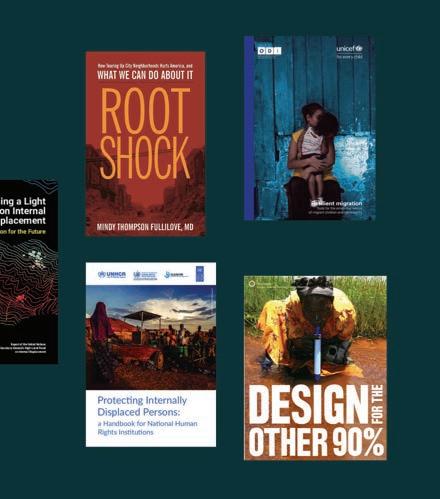

Through the research and my learning from the first semester of Products of Design, I followed the design research process. I started by narrowing down whom I wanted to speak to and how I could speak with them. Since my reach and roots were in India, many of the voices and interviews I heard were from rural agrarian families and children in India, both suburban and city-dwelling. Throughout this process, I encountered some surprising insights, as well as a lot of familiar information that I had read in case studies. Given the contextual heaviness and subjectivity of my topic, I adopted a multifaceted approach, supporting all my findings with case studies to address the solution space.
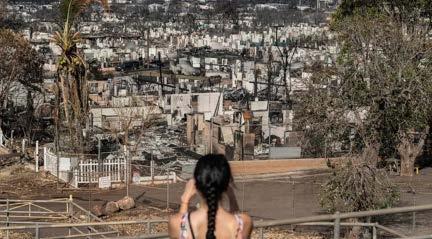
From my primary and secondary research, along with insights from experts, I identified four profound user categories: Child, Family, Society, and the Media Tangible World, all with their unmet needs or unextracted value. The themes that emerged from what my users said included issues with / Financial relief and insurance, / Lack of healthcare services, / Being busy with work and having no time for respite or quality time with family, and / Exploitation.

Although, when I was constructing the user’s world, the layers of complexity didn’t make structural sense to me for the longest time, as every user was in a different part of the journey, a journey which was foreign to my knowledge. To understand this better, I spoke with Justin Paul Ware, who is an Urban Planning Consultant to the Humanitarian and Development Practice at UN-Habitat / Spatial Politics / Climate Mobility / Migration and Displacement
Justin’s interview was where I could really understand how organizations structurally try to tackle the issues of climate migration—or what they technically call climate mobility.
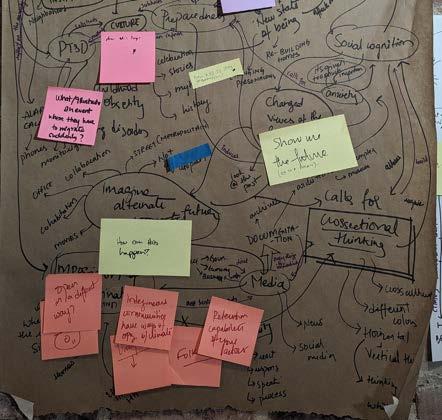
Block by Block began in 2012 with the radical idea of integrating the computer game Minecraft into public space planning to get community members more involved. Minecraft is easy to use, and people of all ages, backgrounds, and education levels can pick it up quickly. It’s a surprisingly effective—and costeffective—way to visualize a three-dimensional environment, in a format designed for rapid iteration and idea sharing. Minecraft helps neighborhood residents model their surroundings, visualize possibilities, express ideas, drive consensus, and accelerate progress.
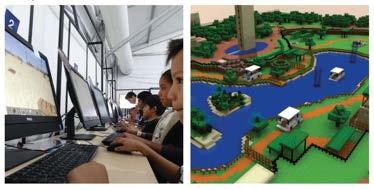






Justin Paul Ware Urban Planning Consultant to the Humanitarian and Development Practice at UN-Habitat / Spatial Politics / Climate Mobility / Migration and Displacement
and operates Spatial Politics, an applied research and design platform established to pursue projects with political and social dimensions. Committed to mentorship and civic engagement, Ware mentors students through the Architecture League of New York’s Mentorship Program and serves as a poll worker for New York City elections. With over a decade of professional experience, he has worked at firms such as Mapos, Grizform Design, and Urban Nouveau. Ware’s educational background includes a Master of Emergency Architecture and Urban Resilience from Università IUAV di Venezia and a Bachelor of Architecture from Rensselaer Polytechnic Institute. His multidisciplinary expertise and dedication to creating equitable and resilient urban environments position him as a valuable contributor to the field of urban planning and design.
Justin Paul Ware is an architectural designer, urban planner, and creative strategist whose work is driven by a commitment to promoting social justice, human dignity, and long-term resilience in the built environment. His approach centers around the belief that design can provide sustainable solutions to the challenges facing a rapidly growing and increasingly mobile global population threatened by climate change. Justin seeks opportunities to collaborate with communities on the creation of cities and spaces that cultivate equity and generate an enduring positive impact. He currently works as an urban planning consultant for the Planning for Humanitarian-Development Practice at UNHabitat (United Nations Human Settlements Programme). Additionally, he freelancers
Q. How do you balance universal design principles with culturally-specific elements in your projects? And how important is Cultural retention?
A. The approach depends on the goal of the output. You can create toolkits, guidelines, systems, or structures that are adaptable to various contexts and cultural conditions, but they need to be somewhat flexible. However, if you want to provide a very specific design response, the cultural element becomes crucial. When dealing with migration and displacement, you often focus on internal displacement. But inevitably, in any city, there will be pockets of migrant communities. These are often the same areas where internally displaced persons (IDPs) will settle, even if
they are not nationals of that country. They will interact with other cultures, languages, and ways of living. Even among IDPs, many rural communities are culturally distinct from urban or metropolitan populations due to rural-urban divides, ethnicity, history, or other factors.In many parts of the world, distinct languages and cultural practices exist just a couple of hours away from major cities in rural communities. Religious spaces can be very important for child protection and response in some contexts, which may not be the focus if you’re looking at it generally, but you can’t avoid it in certain places.
designing in that context, how do you address youth when you’re only hearing men’s voices, who may not be the primary caregivers? For an academic project, you need to narrow your focus and set parameters to avoid spreading yourself too thin. Understand these cultural factors peripherally, then set your rules and work within your area. Focusing on a specific context can be helpful, or you can take a two-tier approach: general guidelines and case studies in specific contexts like Indonesia and India.
it is interesting because it allows you to categorize environmental factors when we have sudden catastrophic events versus the slow decline of agricultural output or the desertification of the land. The decision to move becomes more difficult to fully attribute to just environmental challenges.
If you don’t focus on a specific region, you should still lay out guidelines acknowledging that cultural considerations will be critical in many contexts. For example, the education system may be primarily religious, and if an IDP community arrives with a different religion, it raises implications for access to schooling and potential social cohesion or conflict issues, especially in cases of multigenerational marginalization. In some contexts, like Afghanistan under the current regime, women are not allowed to be involved in certain processes, so if you’re
This allows you to compare and contrast factors, noting where religious components, women’s rights, or education systems were more or less important. There are many factors unique to culture, context, and geography that you should consider, such as whether the target population is coming from rural villages or other backgrounds, as this impacts their needs and experiences.
Q. What are the vulnerabilities in migration especially for children? Moreover Internal displacement?
A. I think focusing on internal displacement makes sense, which is where the majority of environmental migration will occur because there are no border protections. We know that the largest scale of migration and displacement is happening within borders, and that the biggest percentage of environmental migration is occurring over relatively small distances. People are usually moving to secondary or tertiary cities, sometimes primary capital cities, but the barrier of entry in capital cities may be even higher, especially for rural and agrarian communities. Defining your limits and giving yourself parameters sounds smart and positive. In terms of environmental migration, displacement, climate mobility, and these issues, there’s a range of different ways we look at it, which is perhaps unique from some other forms of migration and displacement. We’re trying to respond with different solutions for different situations. One solution is helping people stay where they are through adaptation, mitigation, disaster risk reduction, and other solutions that allow them to remain, as most people want to stay where they are. If the easiest thing is to make adjustments to economic activities, livelihood opportunities, or landscaping solutions that can support annual flooding, for example, that’s the first approach.
overtaxed in terms of service delivery and infrastructure provision. In most cases, they’ll settle informally in vulnerable land within those cities, in informal communities or slums, leading to further challenges, vulnerabilities, and protection issues. The third approach is to avoid this happening in an unplanned, unstructured way where people have to move. Ideally, it should be done in a planned way, like communities in the US accepting sea-level rise and resettling with government support, either as a community or individually. Then there’s planning for receiving cities that will experience large-scale
migration, accommodating the incoming population with services, facilities, and housing to avoid resettling in areas of higher vulnerability.
The next step is thriving in any of those areas, creating conditions for self-reliance, independence, and the ability to adapt to different economic conditions, as most affected people were previously farmers or pastoralists. You don’t necessarily need to address all of that. You could focus on a part of that ecosystem, acknowledging that there are different ways we try to address each aspect in different settings and contexts, sometimes responding and sometimes being proactive to prevent large-scale harm.
The next is to relocate or resettle where necessary, in a planned way, avoiding sudden or unsupported displacement events. This is where the majority of the problem is happening, as most people aren’t being supported to migrate away from rural areas dealing with largescale drought or failing agricultural lands. The vast majority are migrating informally, arriving in cities that are already
Regarding your focus on children and youth, creating safe spaces is crucial, which comes down to street design, street lighting, adequate schools within walking distance, public transportation for safe travel between home and school, and support for families so children don’t have to enter the labor market. All of this has different cultural lenses in different contexts.
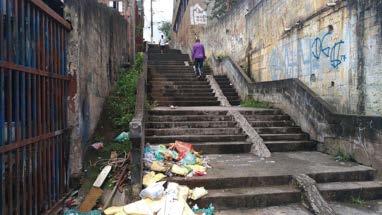
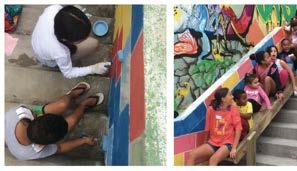
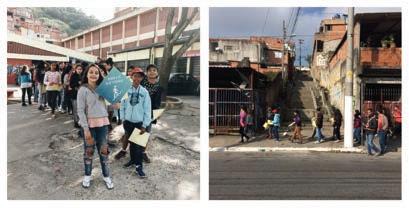
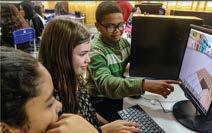

If we draw the user journey of a migrant, there are four distinct stages where climate mobility tries to bring change for sustainability and livelihood.
/ Helping Afflicted societies stay where they are and thrive in current geographic and occupational profile
/ Planned Migration, for mitigating unplanned gentrification and exploitation
/ Planning for Receiving in Host communities, for harmonious coexistence.
/ Providing for Thriving in new societies, taking them from survival to living.
The solutions and proposals of my thesis mainly focus on helping societies thrive in their current locations, although some interventions also address other stages. Moreover, my thesis centers on internally displaced people—these are migrants who do not cross international borders but relocate to new livelihoods within the borders. They often stay in the same location or move towards cities and towns, which are infrastructure hotspots.
I propose that by integrating routines, revitalizing endogenous support structures and community policies, and infusing humanity into the system, we can foster resilience within children’s bodies, homes, and societies. This approach empowers ancestral heritages, family practices, and community building in a healthy manner.
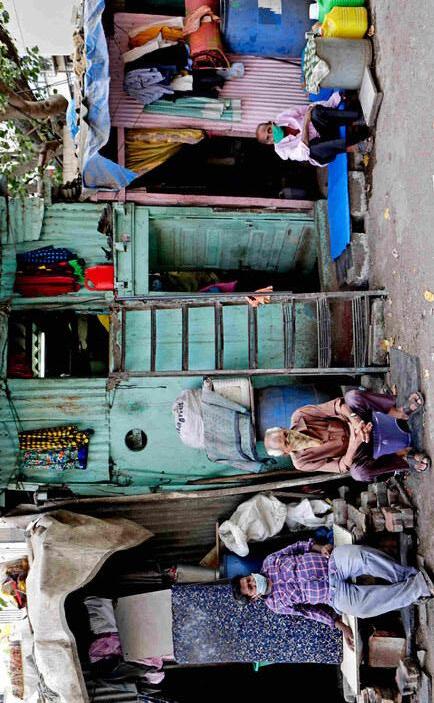

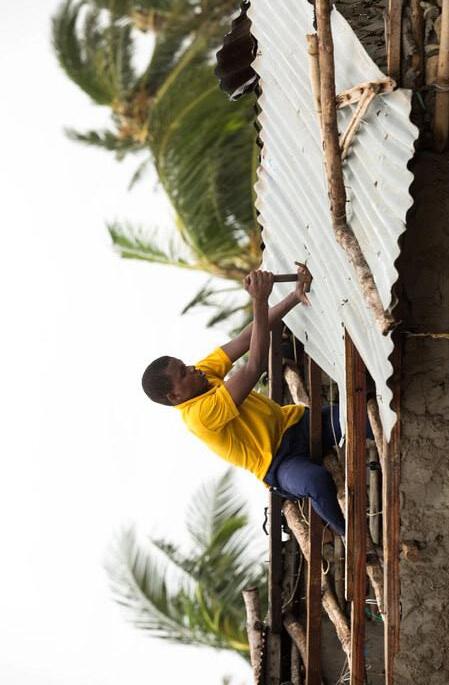
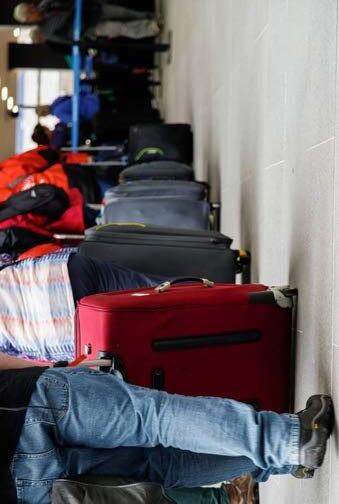
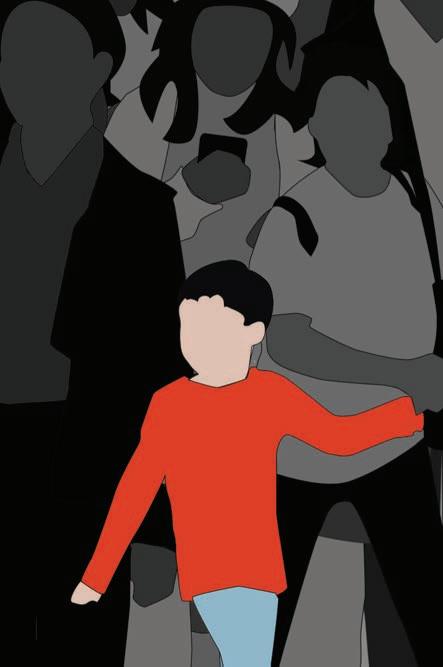

Over the initial six-month period, I dedicated my efforts to translating our research findings into tangible touchpoints with real-world applicability. Through the creation of prototypes, I crafted objects, services, and interfaces that directly reflected the insights gleaned from subject matter experts (SMEs). These prototypes played a pivotal role in guiding the overarching direction of our interventions, shedding light on which areas required immediate attention and prioritization.
Throughout this process, two key principles heavily influenced my design approach: affordability and access. The concept of affordability was central, particularly given that the communities impacted by slow violence are often marginalized due to prevailing global economic structures. As such, it was imperative that any solutions developed were not only effective but also economically viable for these communities. Similarly the notion of access to any resource created or existing is crucial in determining the impact it will create in regards to the specific issue we are aiming to resolve within the realm of Slow violence.
The first ever design exploration towards my thesis was dedicated to understand the emotional journey of someone during a crisis and what they consider important to making it through a crisis situation, for which i designed a survival kit training workshop.
The G0/Bag workshop was an exercise I did in class with my fellow peers and professors wherein within 60 seconds you need to create choose items for survival to make your bag. The workshop aimed at looking at individual choices and finding elements of commonality as well as unique items which someone considered significant to having during and after a disastrous moment.

The Idea stemmed from a personal exercise I did where I built my own G0/Bag. I learnt that for me apart of basic survival items like food, mobile, my passport and a knife, it was also important to have an item of significance like a picture frame of my family and a god’s idol i have at home which will help me navigate the unpredictable scenarios i might enter after being in a disaster.






























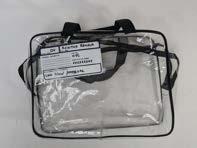
This element was also incorporated into the exercise. The workshop used a paper based gamified experience, where everyone was given a worksheet with 3 columns - Survival, Essential and Significant columns. And a set of stickers.
When the timer starts they had to use the stickers to fill the columns and then only had 60 seconds - the same amount of time you would typically have to make decisions during a crisis.





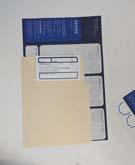


During the exercise I observed how the emotional states of people fluctuated, some were calm while many were worried about the time running out and making the right choices. But everyone, despite time running out, chose to include at least 1 item of significance - something personal to them, while some chose items like pictures, necklaces and objects that carried meaning and essence, others chose their pets and plants. This drew a great insight for me that, even in times of crisis objects of significance, whether their significance is rooted in culture, religion, personality or archetype can be a source of respite and hope, helping an individual in the aftermath of a situation. From that point forward, any intervention or design I created had to consider personalization or incorporate cultural values. Furthermore, I realized that a person’s resilience was not solely influenced by external factors; rather, it should be internalized.
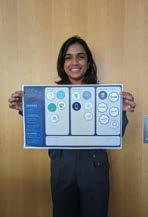
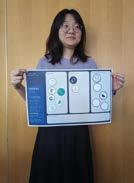

Henceforth, all my design explorations will fall into one of two categories: internalizing resilience through routine and building external structures to support community resources, both of which are essential for community development. I aim to address this with 2 major question
/ How can we internalize resilience by using cultural forces and routines?
/ What social infrastructures do we need to build resilient communities; thereby resilient families and individuals, while allowing societies to flourish in their origin communities?
With these factors in mind my ideas and explorations took the form you will see in the coming chapters. Every project I have done towards this thesis, is attached with a research insight, case study, a how might we statement, followed by the proposed design intervention and feedback.
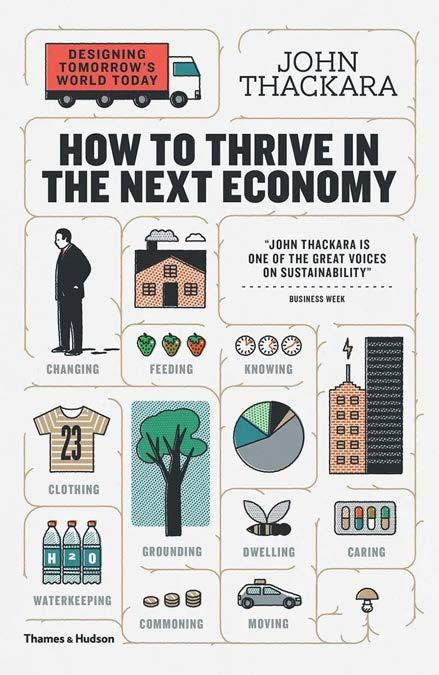
Routine education and access to schooling of any form and shape is crucial for building resilience in children, it not only brings a structure for looking at situations but also instills trust within the environment in children. But a lot of children do not have access to institutional schooling structures.
Schooling structures not only create routine and give education on how to circumnavigate the world, but also on how to identify social structures and build trust systems - Research shows that children develop trust through an expectancy-learning process, where expectations of trust are influenced by experiences of accessibility and responsiveness from attachment figures. Moreover, there are 3 types of adult figures according to children - trusted adults, available adults, and adults who are absent , and knowing the difference allows children to determine with whom they feel safe, dignified and have a sense of belonging.
In terms of building trust with children, interactions characterized by gestures of caring, authentic listening, personalization, consistency, and dependable support are crucial. Trust-building interactions involve going beyond mere niceness and fostering strong relationships that contribute to social, emotional, and cognitive development in children.
Homework can serve as a meaningful way for busy families to connect with their children during periods of neuroplasticity, contributing to trust-building. Trust is a crucial element in children’s personality, social, and intellectual development. Building trust involves interactions characterized by gestures of caring, authentic listening, personalization, consistency, and dependable support. These interactions evolve from directive and transactional at the emerging level to reciprocal and engaging at the advanced level, emphasizing personalized connections and individualized support for growth.
Research highlights that trust development in children is an expectancylearning process influenced by experiences of accessibility and responsiveness https://www.sciencedirect.com/science/article/pii/S0962184905800484, https://turnaroundusa.org/what-do-trust-building-interactions-looklike/, https://www.ncbi.nlm.nih.gov/pmc/articles/PMC6905544/, https://www.kellogg.northwestern.edu/academics-research/trust-project/videos/ koenig-trust-through-the-eyes-of-children-a-psychologists-perspective.aspx, https://www.ncbi.nlm.nih.gov/pmc/articles/PMC3049091/
from attachment figures. Children exhibit selective trust in informants, relying on heuristics like tracking the history of potential informants and monitoring their cultural standing to determine trustworthiness[4]. As children develop, they tend to base their trust more on epistemic factors rather than socio-emotional ones, preferring accurate informants over familiar caregivers.
“… and a lot of parents are not actively involved in their children’s life, because these people are occupied with chores and work. And, children to my amazement identify and associate the role of parents into these categories,- but they don’t know why and that is what confuses them. We have seen children in middle and lower class communities with issues of rage, because they do not understand this and accept it. And parents think that children are being greedy/nagging, but that nagging is not because they do not know, but rather because they don’t understand the why?… So even when parents come together with their children, the bent up emotions play out and lead way into frustrations…”
Kamal Nayak, [SME], Co-Founder - Good UniverseIncorporating homework activities that involve personalized interactions, choice, voice, and support for individual growth can enhance the trust-building process between parents and children during critical periods of neuroplasticity. By engaging in meaningful homework tasks that foster strong relationships and cater to the child’s unique needs, families can create a supportive environment that nurtures trust and contributes to the child’s overall development.

A case study demonstrating the positive impact of educational homework done

at home with parents on fostering prosocial behavior and reducing crime rates can be found in the context of afterschool programs. The Carolina Teen Center, as highlighted in a report, offers crime-reduction programming alongside antibullying initiatives[1]. This program emphasizes the importance of structured activities and educational engagement outside of school hours to keep children safe and reduce juvenile crime rates.
By involving parents in educational homework activities and fostering a supportive environment that promotes prosocial behavior, afterschool programs like the one at the Carolina Teen Center contribute to a decrease in crime rates among youth. These initiatives not only provide academic support but also focus on building social-emotional skills and creating a sense of community that deters delinquent behavior. The involvement of parents in these programs enhances the impact by strengthening family bonds, instilling positive values, and reinforcing the importance of education and personal development in children.
Overall, this case study illustrates how educational homework done at home with parental involvement within the framework of afterschool programs can be a powerful tool in fostering prosocial behavior and reducing crime rates among youth.
Examples of prosocial behavior that can be fostered through educational homework include:
/ Collaboration: Assignments that require group work or peer collaboration can promote teamwork, communication, and cooperation among students.
/ Empathy: Homework tasks that involve reflecting on others’ perspectives, feelings, or experiences can enhance empathy and understanding of different viewpoints.
/ Responsibility: Educational homework that requires students to manage their time, set goals, and complete tasks independently fosters a sense of responsibility and accountability.
/ Helping Behavior: Assignments that involve assisting classmates, providing feedback, or sharing knowledge can encourage altruism and a willingness to help others.
/ Conflict Resolution: Homework activities focusing on problem-solving, negotiation, or conflict resolution skills can equip students with strategies to handle disagreements constructively.
By incorporating these elements into educational homework assignments and encouraging parental involvement in these activities, families can play a https://www.jstor.org/stable/40071154, https://www.pearsonhighered.com/assets/samplechapter/0/1/3/2/0132272350.pdf, https://files.eric. ed.gov/fulltext/ED489760.pdf, https:/content.schoolinsites.com/api/documents/ce5ab25e7c13433cb5b7a1454c3990ea.pdf, https://www. annualreviews.org/doi/10.1146/annurev-criminol-032317-092358 https://pdf.usaid.gov/pdf_docs/PA00XGXT.pdf
significant role in nurturing pro-social behaviors in children. This approach not only enhances academic learning but also contributes to the development of essential social and emotional skills that are crucial for positive behavior and interactions within the school and community.
How might we create internal
resilience within children of marginalized communities using Homework structures as a method to foster resilience, which is accessible and affordable?
HomeGrowing is a Service which works in collaboration with newspapers, non-profits, and local educational institutions to provide a weekly children’s magazine which doubles as a workbook to every child’s home.
Additionally they also work with nonprofits to conduct CSR initiatives which provide facilitations and workshops within existing schools in rural areas, on a weekly basis which include trust building activities for children.
The idea draws inspiration from the block by block initiative by microsoft and takes structural foundation from existing services like Kumon and Scholastic, with the vision of making children resilient towards climate towards building trust and eventually bringing change in the societies they grow up in, by building trust.
The idea of education inspired me to further explore other avenues on how we can include a more comprehensive routine by including the immediate environment of a child. I was keen on exploring the interaction between children’s play, learning and routines, through digital spaces available to these communities
G2C applications, or Government-to-Citizen applications, are digital platforms or services provided by government agencies directly to citizens. These applications aim to facilitate interactions between government entities and individuals, offering various services such as applying for permits, paying taxes, accessing public information, and receiving government assistance or benefits. Examples include online portals for driver’s license renewal, voter registration, social welfare programs, and tax filing systems provided by government agencies to citizens for their convenience and accessibility. In recent years there is a boom
of single mobile applications(m-apps) which provide all citizen services through a single portal.
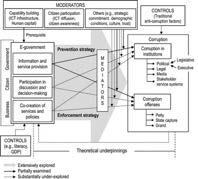
G2C mobile applications play a crucial role in enhancing education accessibility for children in marginalized communities. These applications facilitate various educational services, such as delivering content to students, accessing exam scores, scholarship decisions, and notifying parents about absences. For instance, initiatives like India’s e-learning projects aim to expand educational access globally through a single m-app called UMANG(Unified Mobile Application for New-age Governance). Moreover, innovative projects like “M4Girls” in South Africa provide mobile phones loaded with educational material to help students improve their proficiency in key subjects like mathematics.
If we provide children of low and middle class communities living in rural agrarian communities with a way of education and routine building through and within their immediate environment and agents within that environment;
/ We will observe children will learn to trust with their current environment and agents in their life
/ They will create a routine which will help build their self confidence
/ It will create a medium for educating the coming generation with the tools to navigate climate events while encouraging them to continue to geoengineer with the earth.
Since the COVID-19 pandemic, mobile infrastructure has significantly risen and become more accessible worldwide. Governments are leveraging mobile technologies to provide value-added services like secure payments, educational content delivery, and citizen engagement. The shift towards mobile platforms has enabled real-time access to information and services, benefiting citizens, businesses, and governments alike. Additionally, the use of G2C applications has improved transparency, accountability, and trust between governments and citizens while reducing costs for accessing public services.
By harnessing the power of G2C mobile applications and the increased availability of mobile infrastructure post-COVID, education can be effectively delivered to children in marginalized communities, bridging the gap and promoting academic achievement on a global scale.
This led me to create AGIE, a gamified e-learning platform which uses AR to generate trust building learning activities in congruence with the immediate environment children grow up in like - their homes, backyards, streets, playgrounds, etc.










In today’s rapidly evolving digital landscape, the boundaries between formal education and informal learning are becoming increasingly blurred. The AGIE (Augmented Reality for Informal Education) initiative emerged as a pioneering endeavor to harness the power of technology in transforming informal learning experiences. By leveraging Augmented Reality (AR) technology, AGIE aimed to democratize education and empower individuals to engage in immersive learning experiences beyond the confines of traditional educational settings. AGIE originated from a fundamental question: Why should learning be confined to the walls of educational institutions? Recognizing the abundance of learning opportunities in everyday life, AGIE sought to tap into the potential of informal education. Informal learning occurs naturally through daily experiences, interactions, and observations, offering valuable insights and knowledge acquisition outside formal educational frameworks. AGIE aimed to bridge the gap between formal and informal learning by providing individuals with tools to explore, learn, and grow within their immediate surroundings.

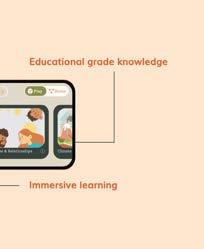




At the heart of the AGIE initiative lies Augmented Reality (AR) technology, which offers a unique medium for immersive exploration and education. Unlike Virtual Reality (VR), which creates entirely virtual environments, AR overlays digital content onto the physical world, seamlessly blending virtual elements with realworld surroundings. This innovative approach allows users to interact with digital information in real-time, enhancing their understanding and engagement with the subject matter. AGIE envisioned AR as a transformative tool for education, enabling individuals to access information, visualize concepts, and participate in interactive learning experiences like never before. Here is what one of the Moms I interviewed had to say :
“Every day, from 8 to 10 in the morning until I have to leave for the office and drop my son at school, we allow him to use our phone for 1 hour of YouTube time and 1 hour of game time. I am not fond of the culturally irrelevant content on YouTube, but as it is the only verified content available to us, I prefer my son to engage with that. At his age, he is not yet ready for platforms like Udemy or Coursera, which offer more meaningful learning objectives. Therefore, games and videos serve as his primary means of learning and entertainment.”
Central to the AGIE initiative was the recognition of the importance of cultural relevance and appropriateness in educational content delivery. In a diverse and multicultural society, education must reflect the cultural backgrounds and experiences of its learners to be truly effective. AGIE aimed to cater to diverse audiences by offering culturally relevant and contextually appropriate educational content. By incorporating cultural elements into AR experiences, AGIE sought to enhance user engagement and foster deeper learning objectives.
AGIE was developed with the goal of providing meaningful learning objectives on specific topics that are culturally relevant, all in a gamified format. The content offered through AGIE is carefully verified and vetted, akin to a syllabus in traditional education systems, ensuring that learners receive accurate and reliable information. Additionally, AGIE emphasizes the importance of creating routines, recognizing that consistency is essential for building trust and fostering a conducive learning environment. Through this approach, AGIE not only facilitates learning but also cultivates a sense of reliability and familiarity, crucial for effective education.
https://www.itu.int/ITU-D/cyb/app/docs/m-gov/Benefits%20and%20outcomes%20of%20M-government.pdf, https://read.oecd-ilibrary.org/governance/m-government/benefits-and-outcomes-of-m-government_9789264118706-5-en, https://core.ac.uk/download/pdf/11241963.pdf, https:// www.hrpub.org/download/20131215/CSIT4-13501900.pdf, https://www.coursehero.com/file/222311044/G2Cdocx/
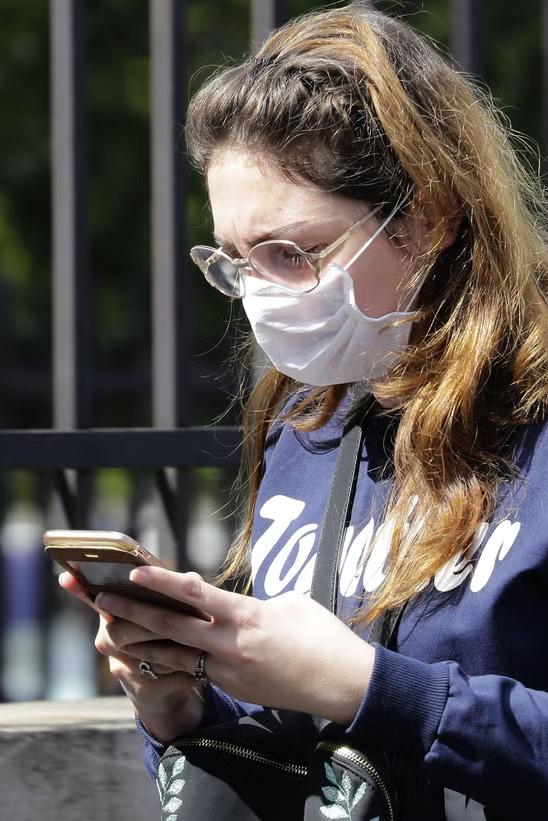
Hence, AGIE is structured to incorporate learning, routine building, and also provide a parent interface that serves as a dashboard view of time spent, learning archetypes and growth patterns.
AR Concerns are also addressed by not allowing image downloads, screen recording or screenshots throughout the application.
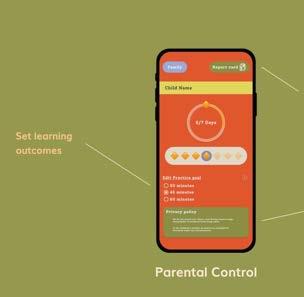
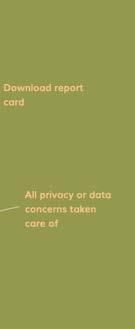
To assess effectiveness and glean insights from successful applications offering immersive and interactive learning experiences, I examined a range of platforms in the market, spanning from children’s games to e-learning platforms and content/social media platforms.
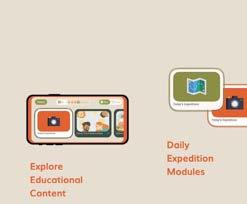

Once the basic learning idea was developed the next step was to break down the various task flows within the application and putting them to test. To do so the first step was to breaks own the various task and their individual learning outcomes.


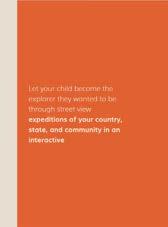

Of these I chose to build on testing the learning fl ow of receiving a reminder, using the application and tracking the progress at the end.


















This is just one of the task flows among the various permutations and combinations of actions.
The next step involved user testing the wireframes. I conducted testing sessions with both parents and children to assess their comfort levels with using the application. Insights were gathered on how parents interacted with the wireframes and their thoughts on letting their children use the application. Additionally, I organized an online workshop with children to understand their preferences for content and interactive experiences. Through these sessions, I gained valuable feedback to improve the application’s design and functionality.
User testing feedback from parents -
“I am more confident in using this application compared to YouTube.”
“I would like to see a few video modules as well.”
“I like the reminder feature, but what if I am not home? When I am home, I have no issues giving the mobile to my child as it keeps them occupied while I can get some work done, which I do anyways.”
“I am definitely interest in the child playing with the camera as logn as it doenst capture any images”
These user testing sessions and workshops helped refine the application. By involving parents and children, I received valuable feedback that guided iterative improvements. Insights from these sessions ensured that the final product met the needs and preferences of its users, enhancing the overall user experience.
/ Appreciation for the application’s curated and verified content, indicating a sense of trust and reliability.
/ Expressing interest in the addition of a YouTube extension or channel to supplement the application’s offerings, suggesting a desire for more diverse content sources.
/ Current usage involves utilizing the application as a tool to occupy their child, allowing parents to attend to other responsibilities or tasks.
/ Recognition of the application’s ability to provide interactive and educational experiences for their children, highlighting its value in fostering learning and development.
/ Preference for characters and personalized content that aligns with their interests and preferences, enhancing engagement and enjoyment.
/ Engagement with augmented reality (AR) features, demonstrating curiosity and eagerness to explore and learn about their surroundings.
/ Ease of navigation and interaction within familiar environments, indicating a preference for simplicity and familiarity in gaming experiences.
/ Impor tance of introducing new and diverse activities to maintain interest and prevent boredom, particularly among children aged 5-7, who may have shorter attention spans and a need for variety.


“The ability to make decisions is not solely dependent upon literacy; it’s also about being healthy. Physiological health adds weight to mental health, enabling one to take good decisions and vice versa”
Mental health plays a crucial role in our ability to make sound decisions. When our mental well-being is compromised, it can significantly impact our cognitive functions, emotional regulation, and overall decision-making capabilities. A healthy mind is essential for processing information accurately, weighing options objectively, and making choices that align with our values and goals.
Children’s decision-making processes are influenced by various factors, including their cognitive development and hormonal levels. Low cortisol levels, a hormone associated with stress response, can aid in decision-making by reducing anxiety and promoting a sense of calm. This relaxed state allows children to approach situations with greater clarity and focus, enabling them to make more thoughtful and rational decisions.
Research suggests that Cortisol plays a crucial role in regulating cognitive functions, emotional regulation, and attentional processes, all of which are essential for effective decision-making. A study by Akinola and Mendes investigated the effect of stress-induced cortisol increases on threat-related decision-making among police officers. The researchers found that larger cortisol increases were associated with fewer errors when deciding to shoot an armed
target, suggesting that heightened cortisol reactivity can enhance vigilance and attentiveness to threat-related cues.
Children’s overall health, encompassing physical, emotional, and mental well-being, is intrinsically linked to their decision-making abilities. A child who is well-nourished, physically active, and emotionally supported is more likely to have the cognitive resources and emotional resilience necessary for effective decision-making. Conversely, children facing health challenges, such as chronic illnesses, malnutrition, or emotional distress, may experience difficulties in making sound choices.
Initially, the focus was on developing products within the realm of education extending an arm from Agie and restory, aiming to provide comfort or accessibility. However, after conducting competitive analysis and market research, it became evident that such products might be too expensive for families in rural and marginalized areas, and they often required the involvement of multiple individuals to be effective.


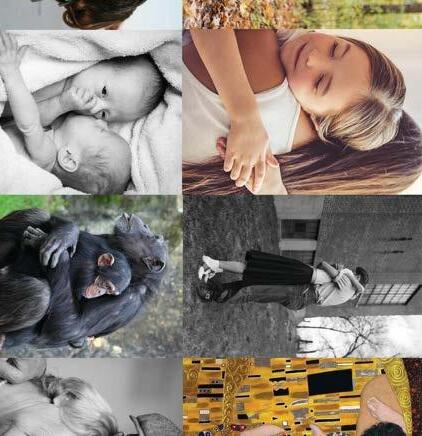

During a brainstorming session, the realization emerged that the true need was not necessarily education but rather an accessible outlet for stress relief. This insight prompted further research into the role of stress in human evolution and the significance of hugs as a means of stress reduction and anxiety alleviation. I did multiple explorations initially focusing on drawing explorations on human and organic forms which give an enveloping feeling and can be incorporated into product forms.
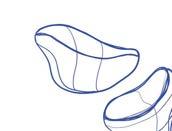
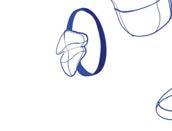
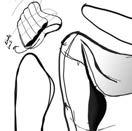

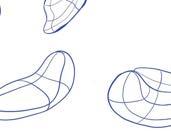





Once i was at forms which excited me and Got feedback on, it was then I started to think about products which can incorporate these organic forms. At this time we were asked to think about the products from a speculative lens, and design a newspaper article on a future on what would happen without the supposed product in the future. I started thinking about why and where organic forms can cause a deficit.

Hugs have been a fundamental aspect of human connection and stress relief since our evolutionary origins as primates. The physical embrace triggers physiological responses that reduce stress and anxiety levels, promoting a sense of warmth and comfort. However, with increasing distances and busy lifestyles, the accessibility of hugs has diminished, posing a potential threat to this essential human need.
Speculating about a future where human connection and hugs are scarce, a hypothetical newspaper spread from 2080 was envisioned. In this scenario, smoking had taken a toll, average life spans had decreased, and family nexuses had disintegrated, highlighting the potential consequences of a lack of meaningful human connection.
his is even true today, modern-day lifestyles have led to increased distances between individuals, making physical touch less accessible. This lack of human connection poses a significant threat to mental health and well-being, with potential repercussions for society as a whole. Without meaningful human connection, we risk facing a future devoid of familial bonds and emotional support.

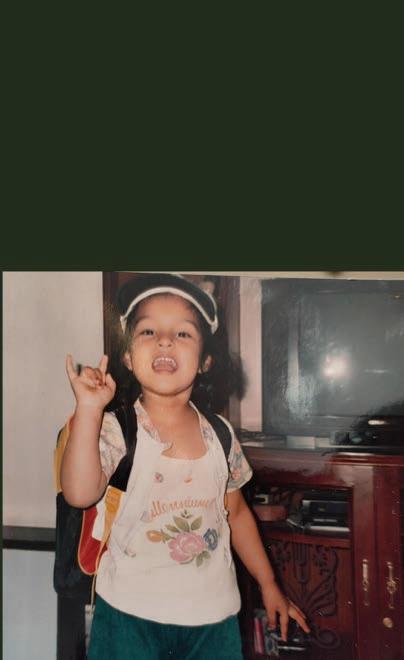
In response to these findings, the focus shifted towards developing products that emulate the comforting embrace of a hug. By exploring forms that evoke feelings of warmth and envelopment, we aim to bridge the gap between physical distance and emotional connection. In doing so, we hope to promote mental well-being and resilience, fostering a future where human connection remains at the forefront of our collective consciousness.
But the question still remained, can a product fill the void that were previously filled by hugs?
To research this possibility I looked into my own childhood, in search of objects and items of comfort, that made me feel the sensation of warmth and safety. This is when I came across my first ever backpack, an object which was my source of wealth back then. A product which every child at least once in their lifetime gets excited about.Me personally loved Hannah Montana pink bags.
This made the designer in me inquisitive. I thought of combining the organic forms to stimulate hugs through huggable backpacks or in this case frontpacks had me excited. I started taking a form that I previously decided and started iterating through context sketches and exploring.
The form started taking that of an almost abstract animal. The research suggests that hugs can activate pressure points on the body that provide calming and therapeutic effects: Weighted blankets simulate the pressure of being hugged, creating pressure points that relieve anxiety and can help with sleep. The weight and pressure from the blanket likely activates the same therapeutic pressure points as a hug.
Studies show that gentle pressure on the sternum (breastbone) during a hug stimulates the thymus gland, which regulates the production of white blood cells and helps strengthen the immune system.

Hugs also increase circulation into the soft tissues by applying gentle pressure, which can help relieve muscle tension and pain. The pressure points activated by the embrace promote relaxation and release of muscle tension.
Additionally, the pressure from a hug is thought to activate the vagus nerve, which is part of the parasympathetic nervous system responsible for resting, digesting, and recovering from stress. Stimulating this nerve through the gentle pressure of a hug helps the body relax and reduces anxiety.

So in summary, the calming effects of hugs are partly due to the activation of specific pressure points like the sternum/thymus area, soft tissues, and vagus nerve when embraced, which promotes relaxation, pain relief, immune boosting, and reduced stress levels.
I started applying this knowledge into [product features of a back, from adding weight to certain parts, and thinking about where texture can help stimulate sensations of warmth. From shoulder straps to chest support and underarm weights.
The final design was made with fur and textured polyester cloth, foam and kinetic sand for featured parts.



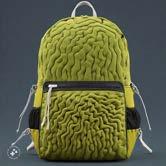
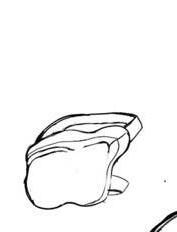
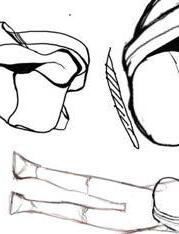
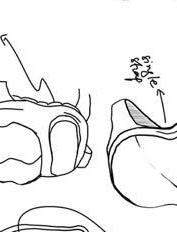




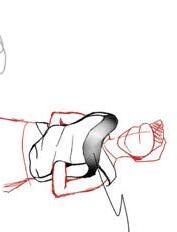
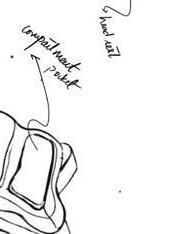
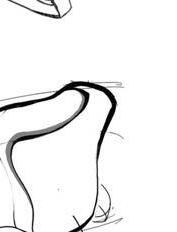
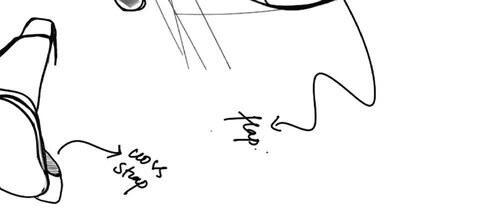
Hoogli is a Huggable front pack designed to stimulate the sensation of hugs through its weighted design. The backpack itself has weight to it which makes a child feel like they are hugging a person.



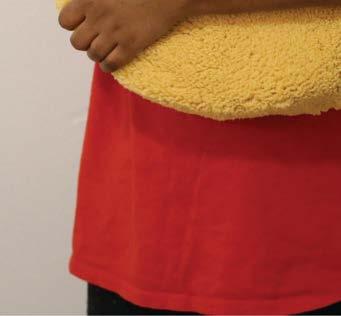




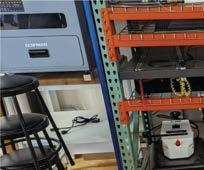

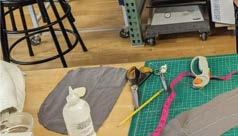
















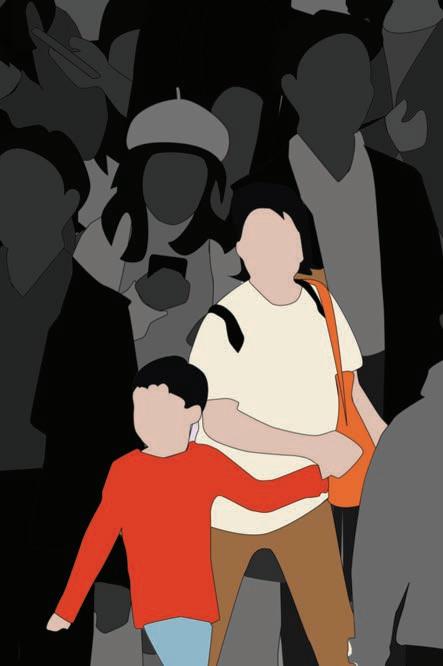
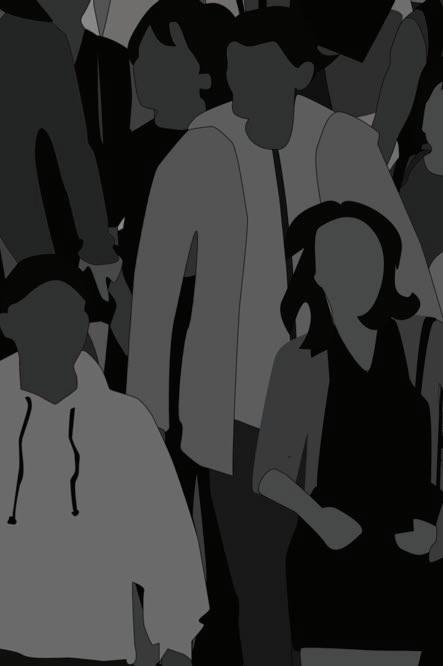
Service Design
While we address Mental health and Literacy, it comes second to physiological health, as the requirement becomes more bodily than just the brain. Overall health and wellbeing is extremely important when thinking about making good decisions
Despite developing any number of products and interventions for children without proper interventions for parents there will always be a gap in creating impact and slow violence will continue weathering the body down without proper and timely care - Healthcare.
When i began my research into healthcare, all my research initially took me into the healthcare industry in the USA, which is so vastly different from that in the global south for a variety of reasons
The healthcare industry in the United States differs significantly from that in the global south (developing countries) in several key aspects. In the USA, healthcare coverage is primarily provided through private insurance plans, often tied to employment, or through public programs like Medicare (for seniors aged 65+) and Medicaid (for low-income individuals/families). However, a significant portion of the population remains uninsured or underinsured. In contrast, many countries in the global south lack comprehensive healthcare coverage, with large segments of the population having limited or no access to essential services due to poverty and underfunded public health systems.
The USA spends a staggering amount on healthcare, nearly twice as much per capita ($12,555 in 2022) compared to the average of other wealthy OECD countries ($6,414). This high spending is driven primarily by higher prices for healthcare services and goods rather than higher utilization rates. On the other hand, healthcare spending in the global south is much lower, with many countries allocating less than 5% of their GDP to health expenditures. Despite its high spending, the USA lags behind other high-income nations in key health outcomes like life expectancy and infant mortality rates. Many developing countries in the global south face even greater challenges, with higher rates of preventable deaths, lower life expectancies, and a higher burden of communicable diseases like HIV/AIDS, tuberculosis, and malaria. The USA generally has a well-developed healthcare infrastructure and a robust workforce of medical professionals, although distribution can be uneven, with rural areas facing shortages. In contrast, the global south often suffers from severe shortages of healthcare workers, outdated medical equipment, and inadequate healthcare facilities, particularly in rural and remote areas. Medicare is a federal health insurance program in the USA that primarily covers individuals aged 65 and older, as well as younger people with disabilities and those with endstage renal disease. It is a single-payer system funded through payroll taxes, premiums, and general revenue. Medicare provides coverage for hospital stays, physician services, and other medical services, but beneficiaries may need to pay deductibles and coinsurance.
The issue became even more clear when I did an analysis on healthcare facilities in Nepal vs in the state of Indiana. -
As infrastructure in the global south undergoes a transformation, an increasing number of healthcare franchises are expanding across various countries in this region. While there remains a notable gap in development and infrastructure, the presence of a substantial number of` doctors raises questions about the involvement of other stakeholders in addressing existing challenges.
So I diverted my attention to actually speaking with experts from the field in these countries from doctors, to diagnosticians, government officials, and even users like farmers, fishermen and more.
After conducting extensive research with doctors, I discovered that healthcare services in the form of health camps do exist, but they are often organized on a hospital-by-hospital basis. Furthermore, these camps typically occur only two or three times a year for about a week each time, focusing primarily on check-ups while diagnostics remain largely uncovered in most cases.
In addition to the frequency of these camps, securing funding emerges as a critical challenge, alongside considerations such as weather conditions and scheduling feasibility. Another barrier arises from the fact that doctors participating in these camps often do so to earn credits, and the range of ailments they can screen and consult on depends on their specialization. Consequently, health camps have increasingly become focused on women’s health issues, reflecting the funding priorities.
In a conversation with Dr. Swetha Ganji from Guntur, India, she shared her experience as a medical student, recalling how she had participated in only two camps during her tenure, one of which was cut short due to severe weather forecasts.
When we delve into the government’s role and the lack of sufficient infrastructure from their end, we uncover a different facet of the issue. Despite having funds and plans in place, the implementation of initiatives is hindered by a significant deficit in data availability.
Funding from government administrations is typically allocated based on historical data, as well as the ability to track where the funds are being directed and who they are serving. This data-driven approach is also the reason why many disaster relief funds often face underfunding – it is extremely challenging to audit progress and measure the impact of such initiatives accurately. Consequently, any future interventions developed to support disenfranchised communities must incorporate a robust system for auditing and measuring impact. Without a reliable mechanism to track the utilization of funds and quantify the tangible outcomes, it becomes increasingly difficult for government agencies to justify and allocate resources effectively.
The lack of comprehensive data not only hinders the allocation of funds but also impedes the ability to identify areas of greatest need and tailor interventions accordingly. Without a clear understanding of the specific challenges faced by disenfranchised communities, government initiatives may fail to address the root causes of marginalization effectively.To overcome this hurdle, a concerted effort is required to establish robust data collection and monitoring systems. This could involve leveraging technology, such as digital platforms and data analytics tools, to streamline the process of gathering and analyzing relevant
information. Additionally, collaboration with local organizations and community leaders can provide valuable insights into the unique needs and challenges faced by disenfranchised populations, enabling more targeted and impactful interventions.By bridging the data gap, government agencies can make more informed decisions, allocate resources more efficiently, and develop interventions that directly address the specific needs of disenfranchised communities. This data-driven approach not only enhances the effectiveness of government initiatives but also fosters greater transparency and accountability, ensuring that funds are utilized in a manner that maximizes their impact on the lives of those most in need.
Refocusing the problem on the end-users – the farmers, fishermen, and other marginalized communities – reveals another critical aspect: the issue of trust and cost-effectiveness in accessing healthcare services. For these disenfranchised groups, the challenge extends beyond the mere availability of healthcare infrastructure; it encompasses the need to establish trust in the healthcare system and ensure that the associated costs do not impose an undue burden on their already strained resources. Building trust in the healthcare system is a multifaceted endeavor that requires a deep understanding of the cultural, social, and economic contexts in which these communities operate. Many disenfranchised groups may harbor skepticism or distrust towards mainstream healthcare providers due to historical marginalization, lack of cultural sensitivity, or perceived discrimination. Overcoming these barriers necessitates a concerted effort to engage with these communities, understand their unique perspectives, and tailor healthcare services to their specific needs and preferences. Collaborative partnerships with local leaders, community organizations, and trusted figures can play a pivotal role in bridging the trust gap. By involving these stakeholders in the design and implementation of healthcare initiatives, providers can gain valuable insights into the concerns and priorities of the target communities, fostering a sense of ownership and increasing the likelihood of acceptance and utilization.
Moreover, the cost of accessing healthcare services is a significant barrier for disenfranchised communities, many of whom live in poverty or have limited financial resources. Even when healthcare facilities are available, the associated costs – including consultation fees, medication, transportation, and opportunity costs – can be prohibitively expensive, deterring individuals from seeking necessary care. To address this challenge, innovative financing models and cost-effective healthcare delivery strategies must be explored. This could involve implementing subsidized or sliding-scale fee structures, leveraging mobile healthcare units or telemedicine platforms to reduce transportation costs, and


exploring alternative payment mechanisms such as community-based health insurance schemes or micro-financing options.Additionally, efforts should be made to integrate preventive care and health education programs within these communities, empowering individuals with knowledge and resources to maintain their well-being and potentially reduce the need for costly interventions in the long run. By addressing the issues of trust and cost-effectiveness, healthcare providers and policymakers can create a more inclusive and accessible healthcare system that meets the unique needs of disenfranchised communities. This approach not only improves health outcomes but also contributes to the overall socioeconomic development of these marginalized groups, fostering a more equitable and sustainable society.
The most intriguing aspect of this puzzle lies at the diagnosticians’ front. Even if the government and healthcare providers are aligned and working together, the reporting process is often ill-structured and fraught with challenges. During the course of healthcare delivery, return addresses can be lost, samples may be handled poorly, and reports can get lost in the mail more than once, creating a break in the feedback loop. Speaking with diagnosticians provided a gamechanging perspective. The gap was not solely the lack of infrastructure itself but the absence of a robust feedback system that effectively serves these rural agrarian dwellers. Unlike their urban counterparts, accessibility to healthcare facilities is much farther for these communities, subsequently making the cost of accessing care more expensive.
Upon conducting a quick analysis of healthcare costs in the global south, I came across articles suggesting that the cost of healthcare in these regions is often cheaper than the transportation expenses incurred by rural dwellers. To gain a deeper understanding, during my next conversation with a user, I performed a cost breakdown analysis.
As you can see from the balance sheet, the cost of traveling is approximately 1.85 times higher than the actual cost of treatment itself. This stark reality underscores the need for a viable solution that can provide routine healthcare access to these communities. I began exploring past projects and case studies, even those implemented during the COVID-19 pandemic when travel restrictions were in place. Two significant projects caught my attention – one in the United States and another in India.The project in the US involved the deployment of mobile healthcare units equipped with diagnostic tools and staffed by medical professionals. These units traveled to remote rural areas, bringing healthcare services directly to the doorsteps of underserved communities. By eliminating the need for long-distance travel, this initiative significantly reduced the associated costs and increased accessibility to essential healthcare.

In India, a similar approach was adopted, but with a unique twist. Local community members were trained as healthcare workers and equipped with basic diagnostic tools and telemedicine capabilities. These community health workers could conduct initial assessments, collect samples, and relay information to medical professionals in urban centers through telemedicine platforms. This decentralized model not only brought healthcare closer to rural communities but also fostered trust and ownership by involving local stakeholders.
While both projects showcased the potential of innovative solutions to bridge the healthcare access gap for disenfranchised communities, their eventual failure can be attributed to common underlying reasons. Despite addressing the challenges of transportation costs and accessibility, empowering rural dwellers to receive routine healthcare services without incurring exorbitant expenses or undertaking arduous journeys, these initiatives ultimately fell short due to a lack of a proper feedback system, poor stakeholder mapping, and a mismatch between government expectations and the business proposition, resulting in the rise of socio-political issues.
The absence of a robust feedback mechanism hindered the ability to continuously assess and improve the services offered. Without a structured system to gather insights and feedback from the beneficiaries, these projects failed to adapt to the evolving needs and preferences of the communities they served. Consequently, the initiatives became disconnected from the realities on the ground, leading to a gradual decline in their effectiveness and relevance.
Furthermore, inadequate stakeholder mapping and engagement proved to be a significant obstacle. Failing to identify and involve key stakeholders, such as local community leaders, healthcare professionals, and government representatives, resulted in a lack of buy-in and ownership from those directly impacted by the initiatives. This disconnect led to a breakdown in communication, trust, and collaboration, ultimately undermining the sustainability of the projects.
Additionally, the mismatch between government expectations and the business proposition of these initiatives created socio-political tensions. Governments often have specific goals, priorities, and budgetary constraints that may not align with the operational models or financial projections of the projects. This misalignment led to conflicts over resource allocation, regulatory hurdles, and a lack of long-term support, ultimately hampering the projects’ ability to thrive and scale.
The rise of socio-political issues further exacerbated the challenges faced by these initiatives. As tensions mounted between various stakeholders, including government agencies, healthcare providers, and local communities, the projects became embroiled in complex power dynamics and competing interests. This environment of mistrust and conflict made it increasingly difficult to maintain focus on the core objective of providing accessible and affordable healthcare
to disenfranchised communities. To overcome these obstacles and ensure the success of future initiatives I developed Pointcare. Pointcare is a mobile healthcare on wheels service. Unlike other services pointcare structures itself as a diagnostics provisions service it has only 3 facilities it offers in a routine manner. A mobile doctoral consultation station, a mobile pharmacy, and a diagnostics center - each with further specialized care.


To make this comprehensive healthcare solution a reality, it is essential to map a blueprint that identifies the key stakeholders involved. By understanding their roles, needs, and expectations, we can create a cohesive and effective system that delivers accessible and affordable healthcare to rural and disenfranchised communities.The User Journey:





































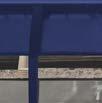



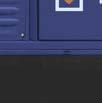


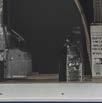




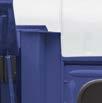

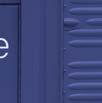




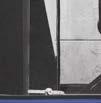



This is the entry point where patients can receive initial consultations and assessments from qualified medical professionals. It is crucial to ensure that the consultation station is staffed by empathetic and culturally sensitive doctors who can build trust with the community and provide high-quality care.
This component is responsible for conducting necessary tests and analyses to aid in accurate diagnoses. It is important to equip the diagnostics center with reliable and user-friendly equipment that can be operated by trained technicians. Additionally, establishing a secure and efficient system for sample collection, transportation, and reporting is essential to maintain the integrity of the diagnostic process.
The mobile pharmacy serves as a vital link in the healthcare chain, providing essential medications and treatments to patients. It is crucial to stock the pharmacy with a comprehensive range of medicines, including both generic and branded options, to cater to the diverse needs of the community. Ensuring the proper storage and handling of medications, as well as the availability of qualified pharmacists, is paramount.










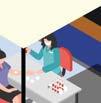



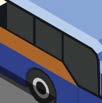






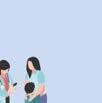
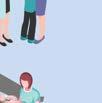

To make this service truly beneficial and sustainable, it is recommended that the healthcare solution be made available to the community every two weeks. This frequency allows for regular check-ups, follow-up treatments, and the monitoring of chronic conditions, ensuring continuity of care and building trust within the community.
Pointcare’s success is made possible by collaborating with a diverse range of stakeholders, each playing a crucial role in ensuring the effective delivery of accessible and affordable healthcare services to rural and disenfranchised communities. The key stakeholders involved in this initiative are as follows:
Local Partnerships:
- Volunteers: Engaging local volunteers is essential for building trust and fostering a sense of community ownership. Volunteers can assist with outreach, education, and logistical support, ensuring that Pointcare’s services are well-received and integrated into the local context.
- NGOs: Collaborating with non-governmental organizations (NGOs) that have a strong presence and understanding of the local communities can provide valuable insights, resources, and on-the-ground support. NGOs can facilitate community engagement, awareness campaigns, and capacity-building initiatives.
Government Agencies:
- Local Government and Political Parties: Establishing partnerships with local government authorities and political parties is crucial for securing necessary approvals, funding, and logistical support. By aligning with local priorities and initiatives, Pointcare can leverage existing resources and infrastructure, ensuring a more efficient and coordinated approach to healthcare delivery.
- Government-funded Hospitals: Collaborating with government-funded hospitals can provide access to healthcare professionals, diagnostic facilities, and treatment options, expanding the range of services available to rural communities.
Healthcare Professionals:
- Private Hospitals: Partnering with private hospitals can provide access to specialized medical expertise, advanced diagnostic equipment, and treatment options that may not be readily available in rural areas.
- Diagnostic Centers: Collaborating with diagnostic centers is essential for ensuring accurate and timely diagnoses, enabling prompt and effective treatment.
Technology Providers:
- Weather Data: Integrating weather data and forecasting services can help optimize route planning and ensure the safe and efficient deployment of mobile healthcare units.
- Route Planning: Leveraging advanced route planning technologies can optimize travel routes, minimize transportation costs, and ensure timely service delivery.








- Designers: Collaborating with designers can help create user-friendly interfaces, intuitive mobile applications, and visually appealing educational materials, enhancing the overall user experience.
- Software Developers: Partnering with software developers is crucial for developing robust telemedicine platforms, data management systems, and other digital solutions that can enhance the reach and efficiency of Pointcare’s services.
- Quality Control and Auditing: Collaborating with quality control and auditing experts can ensure adherence to industry standards, regulatory compliance, and continuous improvement of Pointcare’s processes and services.
- Van Drivers: Reliable and skilled van drivers are essential for the safe and efficient transportation of medical personnel, equipment, and supplies to rural areas.
- Lab Partners: Collaborating with reputable laboratory partners is crucial for ensuring accurate and timely diagnostic testing and reporting.
- Pharmacy Partners: Partnering with licensed and reputable pharmacies can ensure a reliable supply of high-quality medications and medical supplies.
- Auto Mechanics: Engaging skilled auto mechanics is essential for maintaining the mobile healthcare units and ensuring their safe and reliable operation.
- Equipment Installation and Maintenance Partners: Collaborating with experts in equipment installation and maintenance can ensure that medical equipment and diagnostic tools are properly installed, calibrated, and maintained for optimal performance.









By fostering strong collaborations with these diverse stakeholders, Pointcare can leverage their collective expertise, resources, and networks to create a comprehensive and sustainable healthcare solution tailored to the unique needs of rural and disenfranchised communities.
Pointcare was developed with the further aim of establishing Pointcare Resource Hubs, which serve as centralized locations for healthcare services, education, and community engagement.
By mapping the key stakeholders and creating a comprehensive User Journey, we can develop a healthcare solution that addresses the unique needs and challenges faced by rural and disenfranchised communities. Through regular service provision, a focus on diagnostics and treatment, and the establishment of Pointcare Resource Hubs, we can work towards ensuring that every individual has access to quality healthcare, regardless of their geographic location or socioeconomic status.
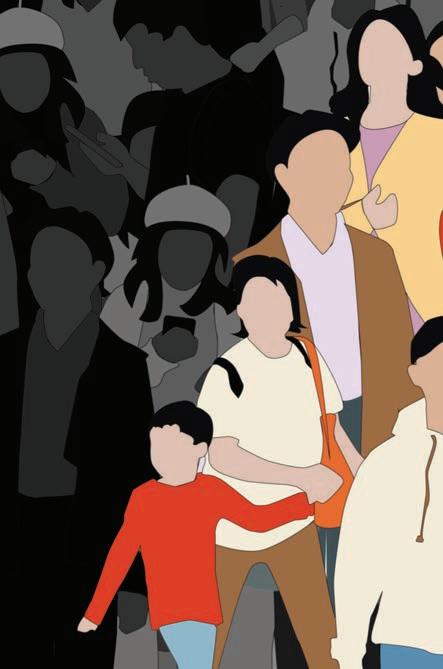

As we delved deeper into understanding the challenges faced by disenfranchised communities, it became evident that slow violence not only manifests in the physical body but also erodes the livability of the environments in which these communities reside. In densely populated urban areas like the chawls of Mumbai, where people live in close proximity, the importance of community engagement and support systems cannot be overstated.
One user shared their experience of a common WhatsApp group chat within their community, highlighting the role of such platforms in fostering
communication and collective action. However, when an entire community becomes disenfranchised, as was the case during the devastating Mumbai floods of 2011, the need for external support from institutions like non-profits, social ventures, and government agencies becomes paramount.
Non-profit organizations, social ventures, and government initiatives have been playing a crucial role in supporting and empowering disenfranchised communities worldwide. These entities work tirelessly to address the multifaceted social, economic, and environmental challenges faced by marginalized populations, providing resources, funding, and innovative solutions tailored to their specific needs. Each organization offers a unique set of products or services designed to cater to the requirements of their target populations. During my thesis work, I had the privilege of collaborating with more than 10 such organizations, gaining invaluable insights into their operational models and approaches.
Non-profit organizations operate with a distinct business model driven by their mission to create social impact rather than generating profits. Their revenue sources typically include donations, grants, fee-for-service income, investment income, and membership fees. Any surplus generated is reinvested back into the organization to further its mission. Non-profits have multiple stakeholders, including donors, beneficiaries, volunteers, staff, and the communities they serve, and balancing their needs is crucial. They are governed by a board of directors or trustees responsible for ensuring adherence to the mission and ethical, financially responsible operations.





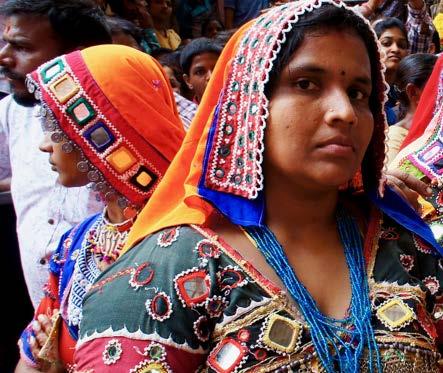
Non-profits can adopt various operational models, such as direct service providers, advocacy organizations, research and policy organizations, or grantmaking foundations. Collaboration and partnerships with other nonprofits, government agencies, or for-profit companies are common to leverage resources and expertise. Unlike for-profits that measure success through financial metrics, non-profits focus on measuring their social impact and program effectiveness in addressing beneficiary needs. While they do not have a traditional profit-driven model, non-profits must still operate in a financially sustainable manner by developing diverse revenue streams, controlling costs, and continuously demonstrating their impact to stakeholders and donors. Among my conversations with one of the micro, small, and medium enterprises (MSMEs) during this research, an entrepreneur shared a profound insight – the lack of trust within disenfranchised communities. Often, these communities seek help only from individuals who share their own caste, creed, or heritage, creating a barrier to accessing external support.

The Lambada tribes in Telangana serve as a poignant example of this phenomenon. Known for their constant migration since early ages, with their occupation as cattle bearers, these tribes have developed a deep-rooted sense of self-reliance and wariness towards outsiders. Initially, I did not fully grasp the significance of this insight about trust, but as I continued my SME interviews, the pattern became increasingly apparent, emerging as a common denominator across various disenfranchised communities.

This observation was further reinforced during my conversation with Vijay Konda of the Hope Foundation, who shared that in many of the tribes they serve, they are not directly involved. Instead, a volunteer from within the tribe acts as a mediator, bridging the gap between the organization and the community. Konda emphasized that when they attempt to approach new communities to extend their support, it often takes weeks, if not months, to build trust through campaigns and needs assessments. This revelation prompted me to question the conventional approach of breaking the trust barrier from the agency’s end. Why should the burden of overcoming this barrier fall solely on the organizations? Could there be a way to reduce the barrier to entry from the communities’ end? And what if WhatsApp, a ubiquitous communication platform, could serve as the medium for facilitating this process?
The idea of leveraging conversations as a means to empower individuals from disenfranchised communities to share their day-to-day issues and challenges emerged as a potential solution. These conversations could serve as a medium for collecting needs assessments through intuitive prompts, fostering a sense of ownership and agency within the communities themselves.
Engaging in everyday conversations with specific individuals can alleviate the burden they carry by providing a platform for them to share their problems, offering one form of support. Extending this principle further, encouraging more people to have open dialogues with institutions that offer assistance
can yield additional benefits. This approach enables individuals to accept help from external sources in a non-intrusive manner, gradually breaking down the barriers of mistrust and fostering a sense of collaboration.
By facilitating these conversations, a wealth of information can be gathered on the ground realities within disenfranchised communities, creating a database that captures patterns and historical data on the commodities and resources that are lacking seasonally. This invaluable data can assist agencies in managing their inventory more effectively, ensuring that the right resources are available at the right time. Additionally, it can provide a solid foundation for agencies to seek funding for future initiatives, as they can represent and measure the tangible impact of their efforts.












However, the question of data integrity and privacy remained a concern. How could we ensure that the information collected was accurate while simultaneously protecting the personal information of the individuals involved? In my search for solutions, I came across three existing platforms and technologies that could potentially address this challenge:
1. Chatwoot - Chatwoot is an open-source, self-hosted customer engagement platform that allows businesses to manage conversations and interactions with their customers across multiple channels from a single dashboard.


2. Signpost - Signpost is a digital initiative and partnership between the humanitarian organizations Mercy Corps and the International Rescue Committee (IRC). It aims to provide critical information to refugees, asylum seekers, and crisis-affected communities, addressing the information gap they often face. Signpost employs a suite of digital tools, including websites, Facebook, blogs, service maps, and social media moderators who are refugees themselves. These tools facilitate two-way communication and guidance in users’ own languages, empowering them with accurate, timely, and actionable information to make informed decisions during crisis situations.

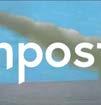
3. Textit - TextIt is a powerful, code-free platform that enables users to create scalable, interactive chatbots quickly using a drag-and-drop flow designer, making it easy to learn and accessible for anyone to build chatbots in minutes.
Its core feature, the Flow Designer, provides a visual interface for constructing chatbot flows by dragging and dropping elements like messages, actions, and rules to create interactive conversations and automate processes. TextIt supports omnichannel deployment across platforms such as Facebook Messenger, WhatsApp, SMS, and Voice, allowing users to reach a wider audience. Designed to handle millions of contacts and billions of messages, TextIt’s scalable infrastructure caters to organizations of all sizes, from small businesses to large enterprises, with pricing plans suitable for different operational scales.


The technology underpinning these platforms revealed the possibility of employing masking algorithms to strike a balance between data collection and privacy protection. These algorithms could mask personal information such as pronouns, names, dates, etc., while enabling the machine learning system to identify and extract relevant keywords that could build data blocks. For example, in a conversation like “Hi Paula, due to the severe storm, our pipeline is not working, and we don’t have gas,” the system could highlight keywords like “gas” and “food” as indicators of essential needs.

But for any new initiative to flourish and gain traction, it was crucial to identify and engage early adopters – individuals within these communities who possessed deep knowledge of the needs and challenges at both the individual family and community levels. Through my research, I realized that there was one potential user group that stood out: women in these disenfranchised communities.
In any community, but particularly in rural, below-poverty-line, or marginalized settings, women often serve as the primary caregivers within their households and broader communities. They possess firsthand knowledge of the needs and struggles faced by every individual in their homes, making them invaluable sources of information and potential agents of change.
This realization was further reinforced during my conversation with a woman in Mumbai who worked as a sweeper for the local municipality. She shared how, during the severe floods that ravaged the city, being able to communicate with her sister over the phone helped alleviate the burden and provided a sense of support and solidarity.
It was from this profound insight that the concept of Syster – a system of sisterhood – emerged. Syster envisioned a conversational chatbot on WhatsApp that could conduct needs assessments and collect data in a non-intrusive manner, while also serving as a synchronous supply chain management communication platform for internal management within non-profits, all within the familiar WhatsApp interface.



This innovative solution would enable non-profits, government agencies, and self-help groups (SHGs) to pull reports and data, and even apply for grants through partnerships, streamlining their operations and enhancing their impact. The interface would allow for smooth operation, with features like sending messages to people who are only active during high alert situations, mimicking the familiarity and ease of managing a WhatsApp group chat, but with additional functionalities integrated into the known interface.
Moreover, the chatbot would add an essential layer of empathy to the process, fostering a sense of connection and understanding between the organizations and the communities they serve.
he benefits of such a solution are manifold:
- Collecting needs assessments across language barriers, ensuring that no community is left behind due to linguistic differences.
- Creating community-wide engagement, empowering individuals to actively participate in addressing their own challenges and fostering a sense of ownership.

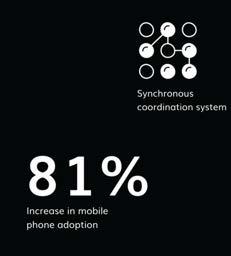
The operational flow of Syster would be as follows:
Everyday conversations, authentic to the users’ conversation styles, would prompt individuals to share information about their needs and the challenges they face in achieving basic living conditions. These conversations would be initiated through the chatbot, leveraging the familiarity and accessibility of the WhatsApp platform.
The shared needs would first be disseminated to local community groups, increasing engagement and fostering a sense of collective action. As similar messages were encountered, they would be clustered and counted, allowing for the identification of patterns and prioritization of needs.
Crucially, personal information would be masked through the use of algorithms, ensuring that the data collected remained anonymous and protected. The remaining data would then be collated into a database and made available as data cards for organizations, providing them with valuable insights into the specific needs and challenges faced by the communities they serve.
Once the necessary materials and resources were procured by the agencies, they would be transported to the respective localities, and a message would be sent to users, informing them of the availability of these goods for collection.
As requests were fulfilled, volunteers could simply reply with an action on the request message, triggering an automated response generator. Through this mechanism, they could provide status updates and ensure a seamless flow of information, further enhancing the efficiency and transparency of the entire process.
Recognizing the sensitivity of the services provided and the fact that volunteers often have their own commitments, introducing an additional management tool or application could create an unnecessary burden and potentially hinder adoption. By leveraging the ubiquity of WhatsApp, which has become an integral part of daily communication for many, Syster aimed to seamlessly integrate into existing workflows and habits, minimizing the need for users to adapt to new platforms or interfaces.
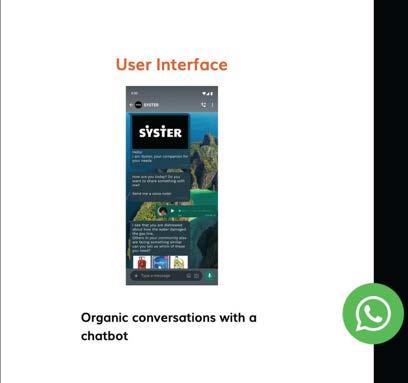
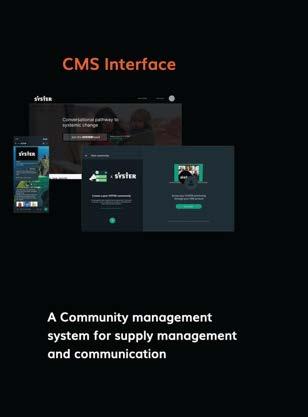
The relevance and accessibility of this solution were further bolstered by the significant increase in smartphone usage since the COVID-19 pandemic, with adoption rates rising from 54% to 81%. This technological shift has opened up new avenues for leveraging mobile-based solutions to address the challenges faced by disenfranchised communities.
By fostering a sense of community ownership, empowering women as agents of change, and leveraging the familiarity and accessibility of WhatsApp, Syster aimed to bridge the gap between organizations and the communities they serve, creating a sustainable and impactful ecosystem of support, empowerment, and collective action.
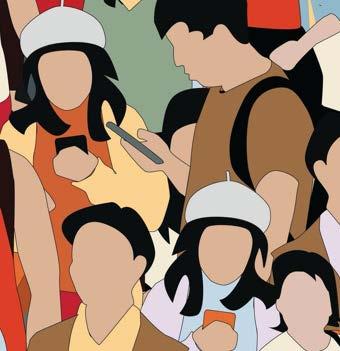
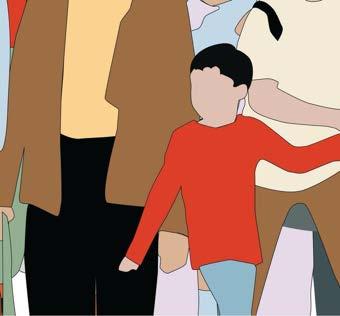




Throughout my thesis, I have had many moments when I contemplated taking this topic. Yes, the sightings and anecdotes I heard motivated me to work on it, but those very conversations were also extremely emotionally taxing. I chose to keep doing it for one reason - design needs to build and advocate for trust. Design has been many things since the beginning of time. For mankind, it was first a tool for hunting, then a way to feel warm. From hieroglyphs for education to maps for sailors to find new worlds - even mechanisms to find those worlds. To today’s modern ways of shaping user behavior, it has seen many forms, but now in the state of crisis, when the human race is at the precipice of transformation and humanity is most needed, we need design to advocate for trust. Design has been an integral part of human civilization since the dawn of time, serving various purposes and evolving alongside our needs and capabilities. In its earliest forms, design was a tool for survival, enabling our ancestors to create weapons for hunting and shelters for protection. As societies advanced, design took on new roles, becoming a means of expression, communication, and cultural identity. The ancient Egyptians, for instance, employed design in their awe-inspiring pyramids, temples, and monuments, incorporating intricate hieroglyphics, sculptures, and architectural elements that not only served functional purposes but also conveyed their beliefs, values, and artistic vision. Similarly, the classical Greek and Roman civilizations made significant contributions to design through their sculptures, pottery, mosaics, and architectural masterpieces like the Parthenon and the Colosseum, which continue to inspire and influence design to this day.
Throughout history, design has been a reflection of the human spirit, adapting to changing cultural, technological, and societal contexts. The Islamic world, for example, is renowned for its intricate geometric patterns, calligraphic art, and architectural marvels like the Alhambra palace and the Taj Mahal, which showcase the intricate interplay between design, religion, and cultural identity. As societies evolved, so did the role of design. During the Middle Ages, design flourished in beautifully illustrated manuscripts, stained glass windows, and ornate architectural details in churches and cathedrals, serving as a means of education, storytelling, and spiritual expression. The Renaissance period witnessed a revival of classical art and design principles, with artists like Leonardo da Vinci and Michelangelo creating iconic works that influenced design for centuries to come. The Industrial Revolution brought about a significant shift
in design, as mass production and new manufacturing techniques necessitated a rethinking of design principles. This period saw the emergence of new design movements like Art Nouveau and Art Deco, which celebrated organic forms, curved lines, and geometric patterns, influencing architecture, furniture, and decorative arts. In the 20th century, design movements like Modernism and the Bauhaus school embraced simplicity, functionality, and minimalism, shaping the aesthetics of architecture, product design, and graphic design. These movements challenged traditional design principles and paved the way for new forms of expression and innovation. Today, design has taken on a multitude of forms, from shaping user behavior and experiences in digital interfaces to addressing complex societal challenges and advocating for trust and humanity. In a world where technology and automation are rapidly transforming our lives, design plays a crucial role in ensuring that these advancements are grounded in human values, empathy, and ethical considerations. As we stand at the precipice of a transformative era, where the human race faces unprecedented challenges such as climate change and its human ramifications, design must step up and advocate for trust. While design can achieve many remarkable feats, it is the virtue of humanity that remains visceral and unique to our species. Through these projects, I hope to create a planned infrastructure that can help communities combat the everyday violence brought on by climate change and its human ramifications, turning the question of choosing to stay and rebuilding into an affirmation. By leveraging the power of design to build trust, foster empathy, and amplify human voices, we can create solutions that not only address the physical challenges but also the emotional and psychological impacts of these crises. Design has the potential to bridge divides, foster understanding, and inspire collective action. By advocating for trust and prioritizing human-centered approaches, design can play a pivotal role in shaping a future where technology and progress are balanced with compassion, inclusivity, and a deep respect for the inherent dignity of all human beings. In this era of rapid change and uncertainty, design must serve as a beacon of hope, reminding us of our shared humanity and guiding us towards a more just, equitable, and sustainable world. By embracing the transformative power of design and harnessing it to build trust and advocate for humanity, we can create a future where no one is left behind, and every individual has the opportunity to thrive and contribute to the betterment of our collective existence. Because while design can do many things, humanity is still a virtue very visceral to humans and humans only.
Through these projects, I hope to create a planned infrastructure that can help communities combat the everyday violence brought on by climate change and its human ramifications, turning the question of choosing to stay and rebuilding into an affirmation.
Nixon, R. (2013). Slow violence and the environmentalism of the poor. Harvard University Press.https://cmc.marmot.org/Record/.b36089758
Coined the term Slow violence, which is used to define the anxiety and stress that accumulates within a person’s body through their environment, and then impacts the same environment due to maladaptive behavioral changes. a violence that occurs gradually and out of sight, a violence of delayed destruction that is dispersed across time and space, an attritional violence that is typically not viewed as violence at all.
The body Keeps Score Van der Kolk, Bessel A. “The body keeps the score : brain, mind, and body in the healing of trauma.” New York, New York : Viking, 2014. Bessel A. Van der Kolk, a leading psychiatrist and trauma expert, delves into the profound impact of trauma on the human body and psyche in “The Body Keeps the Score.” This seminal work explores how trauma, whether from childhood abuse, war, or other sources, can reshape the brain and manifest in physical and mental health issues.
Van der Kolk introduces diverse therapeutic approaches, including neurofeedback, yoga, and Eye Movement Desensitization and Reprocessing (EMDR), shedding light on innovative methods for trauma recovery.
Early Childhood Development in Emergencies
Integrated programme guide, https://www.unicef.org/documents/earlychildhood-development-emergencies
Importance of host communities whether the displacement is internal or external is crucial to the sustenance of the displaced population. Education agencies, and medical camps become primary to socialization, for communities in emergencies, especially climate related.
The genetic and somatic expressions of trauma: A review of pathology and treatment, Nicole Gorra, https://docplayer.net/235440868-The-genetic-andsomatic-expressions-of-trauma-a-review-of-pathology-and-treatment.html Trauma impacts the brain’s neurobiological responses or otherwise manufacturing processes-how it communicates with the rest of the body. Conversion disorders are expressions of trauma-the body’s expression of repressed traumatic memories
The article gives a detailed overview of what happens to the anatomy and the soma, when cortico-limbic acid is produced as a result of stress.
https://www.pacesconnection.com/blog/the-developing-brain-and-adversechildhood-experiences-aces
There is an intricate relationship between adverse childhood experiences and the developing brain, contributing to the ongoing discourse on childhood trauma and its long-lasting effect. There is change in the brain’s physiology, and hence how it literally perceives information due to the already formed neural connections. This also corroborates to high density neural networks which are the root for maladaptive changes in the body.
https://www.washingtonpost.com/health/interactive/2023/ stress-chronic-illness-aging/
Weathering was originally coined as a term for describing the effect of toxic stress borne from the multicultural issues - like microaggressions, discrimination, etc - that were experienced by the African American and other indigenous communities. But this article explores its effects on a human in general and how its translates into the body, and even into the next generation, through eugenics.
Lange, A. (2020). The design of childhood: how the material world shapes independent kids. New York, Bloomsbury Publishing.
The book talks about designing childhood experiences and delves into the different components involved when designing for children and how certain components make up certain environments. Also how progression in age and realization of identity reciprocate to how they interact and how much they interact with spaces vs objects vs people.
[1] https://southshoretherapies.com/b/what-are-activities-of-daily-living-adls
[2] https://online.regiscollege.edu/blog/11-tips-for-teaching-activities-of-dailyliving/
[3] https://beyondboundaries.us/activities-of-daily-living-what-are-they-howtherapy-can-help/
[4] https://sensiblespeech.com/what-are-activities-of-daily-living-adls-forchildren/
[5] https://www.theottoolbox.com/self-care-for-kids-with-special-needs/ https://www.fujixpassion.com/2016/11/18/using-photography-to-make-socialimpact-visible/
https://www.colorado.edu/today/2018/12/05/sos-tips-utilizing-yoursmartphone-emergency
https://www.aesanetwork.org/blog-204-strengthening-local-forestgovernance-to-restore-forests/
https://www.ipasdevelopmentfoundation.org/community-engagement
[1] https://robyngobbel.com/kidswithtoxicshame/
[2]https://theonlinetherapist.blog/toxic-shame-how-children-cover-up-toxicshame-with-primary-ego-defences/
[3] https://www.verywellmind.com/autonomy-versus-shame-anddoubt-2795733
[4] https://www.peacefulparenthappykids.com/read/child-toxic-shame
[5] https://www.soulsandhearts.com/blog/how-parents-use-their-children-toavoid-feeling-shame/

I’m a multidisciplinary experience designer with a background in frontend development, customer experience product management, and communications design.
Leveraging my expertise in systems thinking, I identify connections between elements in seemingly disparate industries to design products that revolve around human experiences and drive successful adoption through collaboration with a variety of stakeholders.
My previous work includes designing for Real-estate marketing, EdTech, Nonprofits, and Fintech.
Rohitha Remala @rohremala rremala@sva.edu rohremala.com
